Alpha Omega: The Beginning and the End by EclecticTastes
it died after about six months for reasons that will become apparent
Original SA postHey, so, I just remembered this here game existed, and apparently nobody else has ever seen it because it died after about six months for reasons that will become apparent as we explore:
Alpha Omega: The Beginning and the End
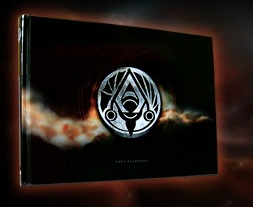
Yeah, the cover's not much to look at, but the artwork inside the book is great, but I'm getting ahead of myself. Cast your minds back, if you dare, to the halcyon days of 2008. Everyone was excited to vote for one Barack Obama, celebrities died by the dozens, and nerd culture, such as it was at the time, had become consumed... with a mystery. A trailer had released, depicting some sort of cataclysm in New York City. One moron misheard a snippet of dialog and thought it would be Voltron. Then the viral marketing began, an ARG that swept the internet. Fans debated and argued what the nature of this film. Would it be Godzilla? Evangelion? Some sort of remake of The Stuff? In the end, it was a technically competent but utterly forgettable giant monster movie, titled Cloverfield.
Why am I bringing this up? Because amidst this flurry of speculation, an anomaly arose. "Ethan Haas was right" was an ARG that for most of its run was widely believed to be related to Cloverfield. However, after weeks of confusion, the solution to the puzzle was revealed. It wasn't Cloverfield at all. It was Alpha Omega, a new post-apocalyptic RPG that had nothing at all to do with Cloverfield. Everyone more or less immediately lost interest.
Flash forward just a few months. I'm at the FLGS for a Free RPG Day promotion, and get talking with someone as I'm waiting for people to gather to play games. He mentions he's promoting a game. Alpha Omega. I recall the ARG and the vast disappointment that followed the reveal. I decided to talk a bit with the guy, learn what all the hubbub was supposed to be about. He tells me a little about the game, but it's clear he's fairly uninterested in the whole "promotion" thing. He was apparently given a copy to hand out, and as the first person to talk to him, he palms it off on me so he can consider his volunteer job done. It's the first RPG book I'd ever owned.
The game line died out quickly, its insistence on too-high-for-tabletop-RPGs production values, expensive ARG, and decision to just hand out a bunch of free copies up front led Mindstorm Labs to close quickly, before they could even put the monster manual into full production. A decade later, and I might be the only person who's ever read the whole core book. Well, let's dig in, shall we?
The Premise
As I mentioned, Alpha Omega is post-apocalyptic. What kind of apocalypse? Pretty much all of them. Hundreds of years in the future, humanity's hubris led nature to revolt, with years of storms, volcanoes, the works. Humanity responded by going to war with each other, dropping bombs, releasing manmade plagues, developing murderous AI, all of which went basically how you'd imagine it. After that, meteors began bombarding Earth, wiping out what civilization remained and, perhaps ironically, preventing the other apocalypses from spreading enough to truly wipe out humanity. Then, the aliens came.
Every 10,000 years, the Seraph and Ophanum, two races of aliens, would arrive on Earth to war with one another. Why? Nobody knows. The Seraph look like Renaissance depictions of Biblical angels, the Ophanum like demons, and serving them both are a bioengineered slave race, the Grigori, whose looks depend largely on the purpose they were designed for. All of this was predicted by a 19th-century author named Ethan Haas. No, nobody knows how or why.
Now, a few cities remain in the world, amid the blasted wastelands, and humanity has spent the last two centuries recovering, though many have been mutated severely, into what are effectively new races. Also there are bioengineered humans that were once and still frequently are used as servants, soldiers, etc. Also cybernetics. And did I mention that when the aliens came, they brought magic with them? Wielders, individuals who could exert influence over matter and energy through force of will, began to appear among the human population, and naturally exist among most non-human races. And that's where the players come in.
Now, you may think that someone had way too many ideas and crammed all of them into a single game, and that it would come off as an unfocused mess as a result. You would be right!
Chapter 1: Three ways to play!
The opening of the book suggests not one, not two, but three distinct ways to represent the game's action. As one might expect, they include "just use your imagination and don't bother with minis" and "get some minis and a grid", but, always the ambitious one, Alpha Omega also suggests setting up some terrain and measuring things in inches, like a wargame. The measurements they give, then, are designed to be applicable to all three of these styles. To their credit, this works out decently.
This chapter also includes the basic RPG boilerplate, explaining the basic concept, and what you need to play. Of note is that it requires at least one of every single die type, from d4 all the way to d20. I should mention that this game uses dice pools for rolling. Feel that chill down your spine? There's a reason I'm doing this in October. But it'll be a while before we get the dice out.
Chapter 2: Remember how we had an ARG?
Alpha Omega devotes an entire chapter of two whole pages to talking about how Ethan Haas was a writer in Paris who released a book of fiction then mysteriously vanished and then when all the apocalypses happened people realized (despite his book being forgotten by history?) that his book was actually a prophecy. The whole thing seems to exist to justify the ARG, and that's it.

The face of a prophet.
Chapter 3: A whole lotta nonsense.
Finally, a chapter with more than five pages. It opens with a two-page version of the story I told up above, then jumps right into a glossary of setting-specific jargon, and yes, it will all be on the test. The only term of interest for you, gentle reader, is "Elim", a term used to refer to both races of warring aliens collectively without having to say "Seraph and Ophanum" every goddamn time they come up. However, the glossary also reveals that there remains a worldwide internet, organized banking, and other modern trappings. Oh, you thought this was just a post-apocalyptic RPG? No, you see, it's post-apocalyptic for most of the world, but in the few remaining cities, it's more like Shadowrun. Because who needs a consistent tone?
Chapter 3 goes on to describe the conventions of this new world. The City-states, literally the surviving cities turned into powers unto themselves, are cyberpunk dystopias, while the Freezones, between them, are terrifying hellscapes full of mutant monsters, murderous robots, alien warriors, and deadly weather, with the occasional peaceful area that serves as home to a small village or city-state colony. Some cities have giant walls around them, and there are several largely self-contained arcologies, which function more or less identically to normal cities aside from being closed in to varying degrees. The chapter goes on to explain that energy and food production are actually quite stable because of future science, and it's raw building materials that are the most sought-after resource, and the most common cause of violence between city-states. So far, so normal.
The rest of the chapter proceeds in this fashion, discussing the difference between people granted citizenship in the city-states and those force to live on the fringes of society, language, food, finance, the internet, and so on. Of note is that Augmented Reality is a significant part of life within cities, with pretty much everything you own doubling as some form of "smart" device. The most popular form of entertainment is basically MMA meets pit fighting. Also cities offer free healthcare because, apparently, medical supplies remain quite abundant in this world.
In the next section, the book describes how most animals and plants on Earth have mutated terribly and are all extremely deadly. Seemingly alien and/or extradimensional entities are also out there somewhere.
From there, the book goes into detail about the aliens, and all that's important is that they're just better than humanity and we're all fucked if they decide we're a problem rather than a resource, and that they've had agents here all along, prepping the world for their return since the last time they fought on Earth.

Just your average alien infiltrator, on his way to work.
Next, the basic mechanics of Wielding are explained. In-universe that is, there's two whole chapters between us and anything resembling game mechanics. Wielders affect the world using a combination of Sources and Intentions, and if that sounds a bit like Ars Magica, that's because it is. Spellcasting itself is also split up into those who can Wield innately, those who learn it through study, and those who come to it through faith. What's that? Sorcerer, Wizard, and Cleric? Never heard of 'em! However, this is where we see the first mention of the titular Alpha and Omega, which are the Sources used exclusively by "Spiritual Wielders", our Cleric equivalent. Alpha is basically the primal force of positivity, love, and kindness in the universe, while Omega is the opposite. They sure sound a lot like positive and negative energy from D&D, but, when you finally learn how they work in-game, well, I'll wait until we're at the chapter on magic for that.
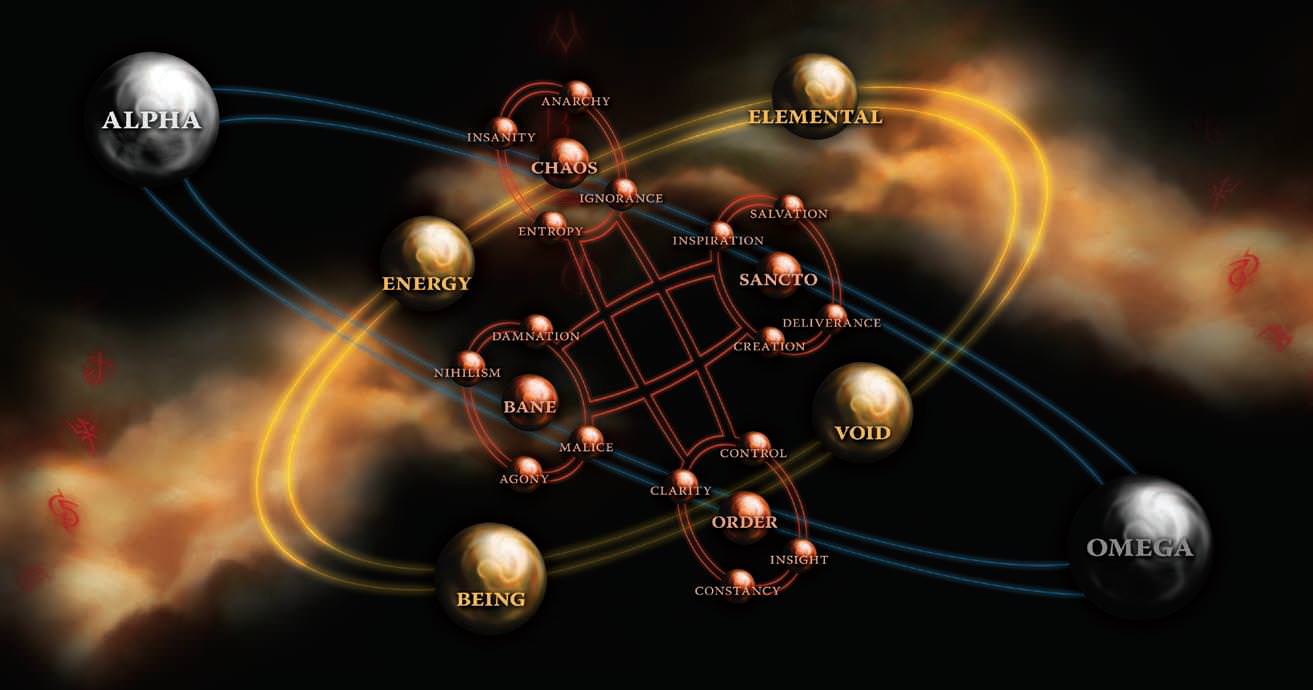
Not pictured: an explanation for what any of this means. Imagine four balls in a ring in outer space...
After Wielding, there's a bunch of pages about technology and bioengineering, it's all your typical cyberpunk fare. Is "cyberpunk heartbreaker" a term yet? Alpha Omega proves that it should be.
The chapter closes with a one-page description of the war between the Elim. Basically, we're all in the middle of a three-year mustering period, during which the two sides gather their forces. After that, all hell will break loose, and humanity will get a chance to maybe influence how the war goes. Right now, there's only a few Elim on Earth, but within a year, thousands will arrive. Hope you don't have any long-term campaigns planned!
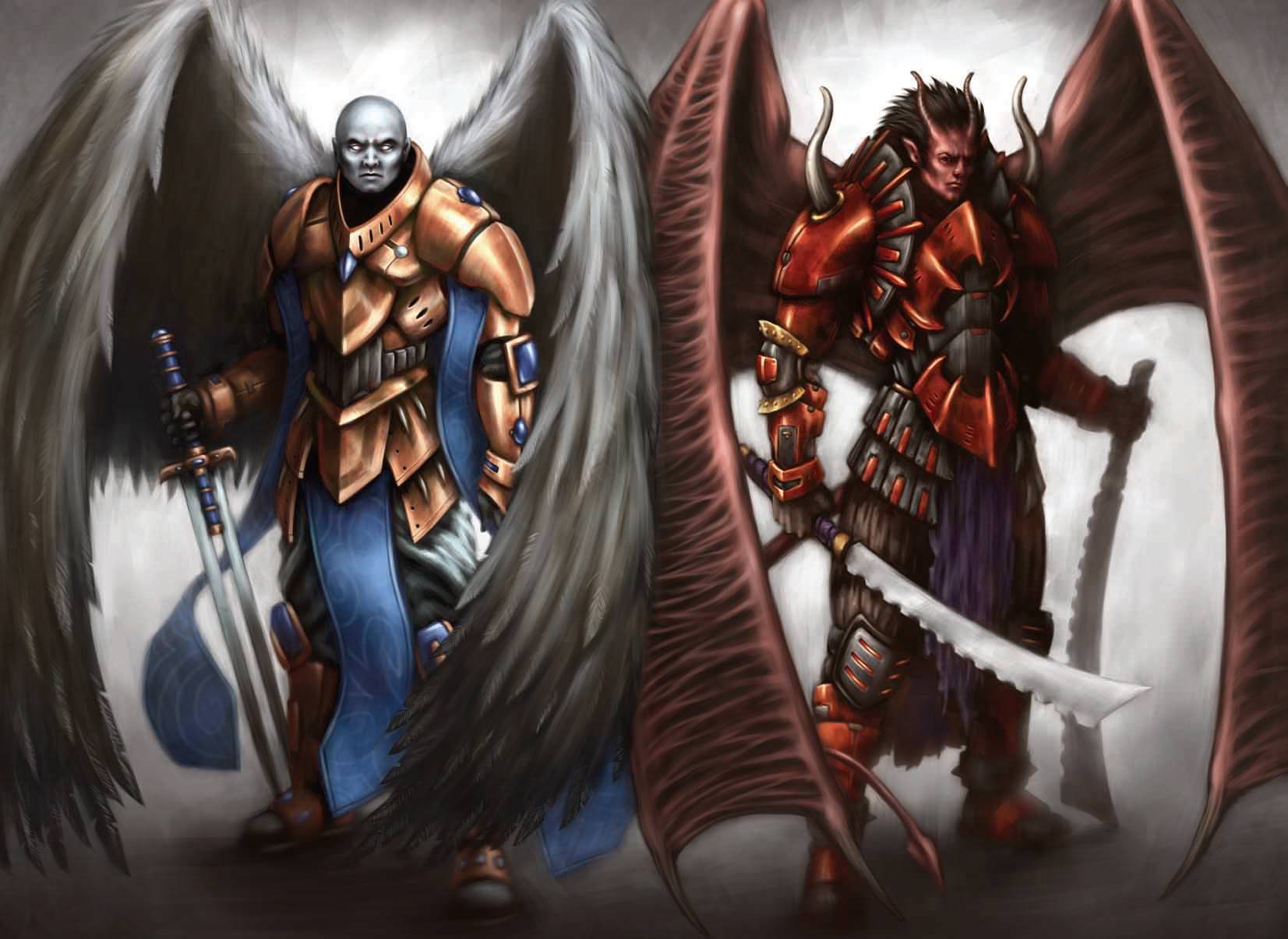
Oh, right, this is what the aliens look like. They made a fucking ARG to promote this.
Chapter 4: Oh, I see the problem, they put the back of the book first.
Chapter 4 is yet more setting information, because fuck putting character creation up front, the writers want you to see how brilliant and interesting this world is! Now they're on to describing all the major locations of the world. Most areas are pretty normal for the genre, all the major cities you expect to still be standing, are. However, there are a few interesting locales. The Loth Foundry is home to a rogue AI who has a massive robot army but isn't trying to kill all humans at the moment, though visitors are decidedly unwelcome. Sanctuarium is the home of the Necrosi, a mutated offshoot of humanity I'll go into more detail about when we get to character creation in chapter 6. However, for the most part, the locations in the game are pretty basic.
On the other hand, credit where it's due, Alpha Omega includes cities suitable to any sort of campaign tone. The Parisian arcology of "Arcon-C-Hell" (originally named "Arc-en-Ciel" but future people are Very Clever) is a hive of crooks and murderers, Terranova City (on the Yucatan Peninsula) is largely democratic and advanced but dangerously polluted, The Island City of Divinus (off the coast of Brazil) is basically Las Vegas But Bigger, Lavan Free City (in Spain) is as close to a "good guy" city as one gets (and it's not even doomed!), and so on. None of them are especially fresh or different, but at least there's a lot of them to choose from, I suppose.

Tag yourself, I'm the six-story tall martini.
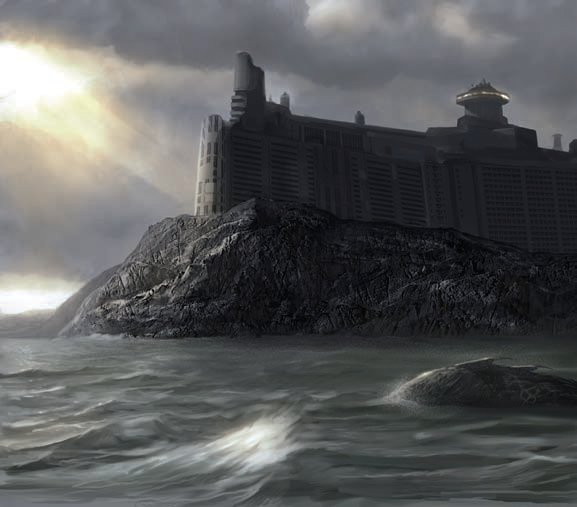
Oh, and there's a giant corporate-owned prison island, in case you were worried the LITERAL END OF THE WORLD might hinder the prison-industrial complex.
Chapter 5: For fuck's sake, just tell me the rules!
Chapter 5 is the chapter all about the unforgettable and unique characters and organizations populating this vibrant, interesting setting. While the personas dramatis are pretty much a collection of stock character types, this is where the artwork in the book starts to shine. It's not perfect, but a lot of effort went into it, clearly, and I'll admit I found many of the character designs appealing, even if most of them are pretty fuckin' goofy. So, rather than drone on about a bunch of people that absolutely do not matter to 90% of prospective GMs, have some pictures:
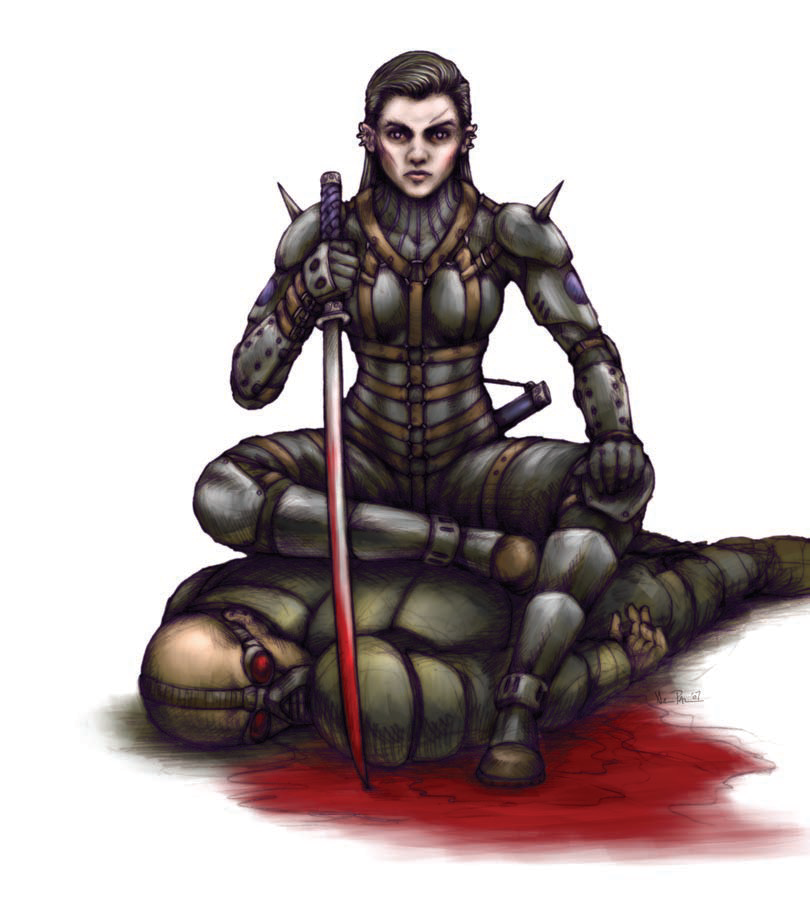
The spikes and leather straps say "post-apocalyptic" but the katana says, "yeah this is still cyberpunk somehow". Very chic!
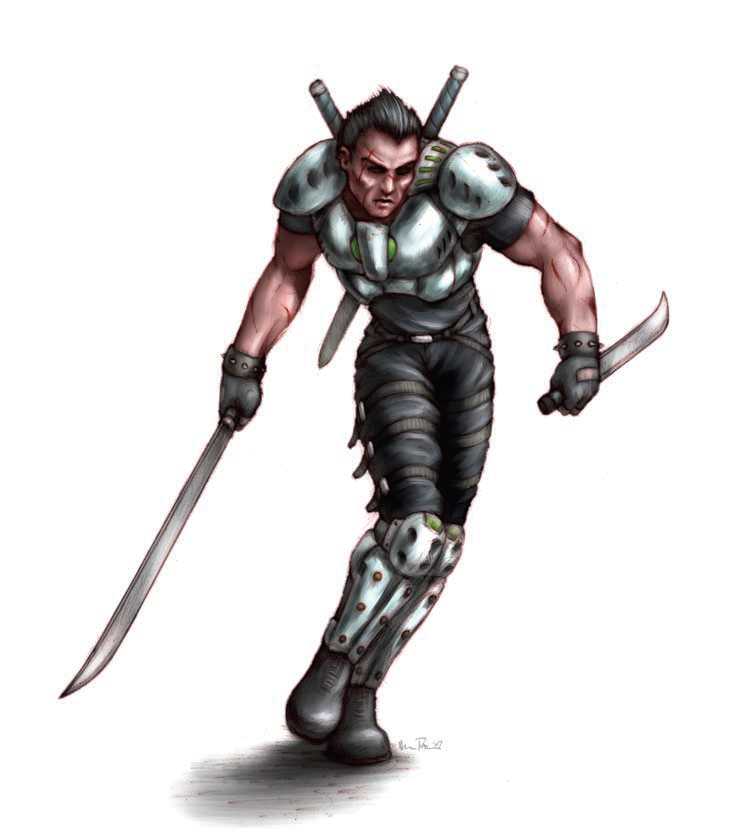
Okay, it's not all great, such as this fellow with SEVERE back issues.
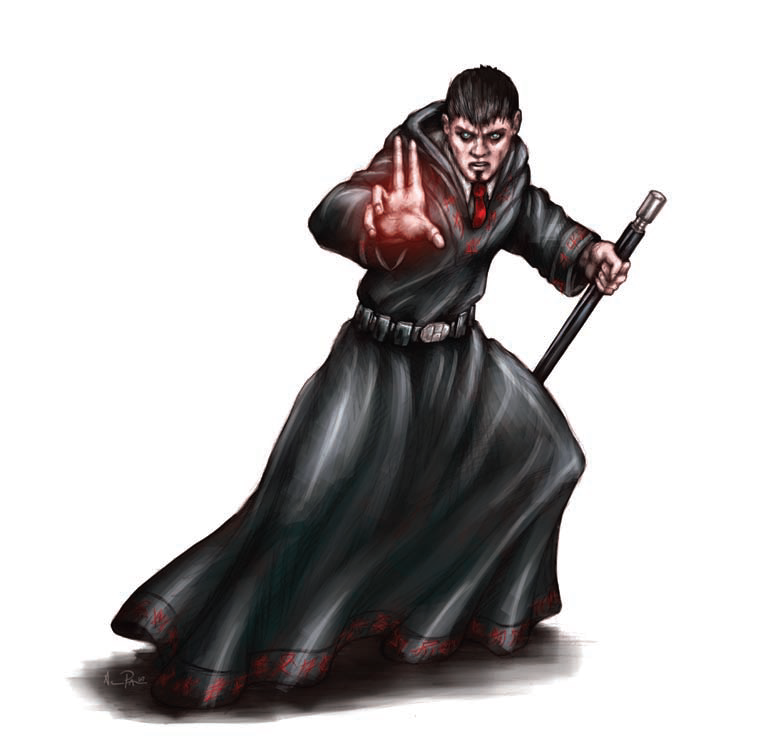
Harry Potter and the Ill-Advised Soul Patch.
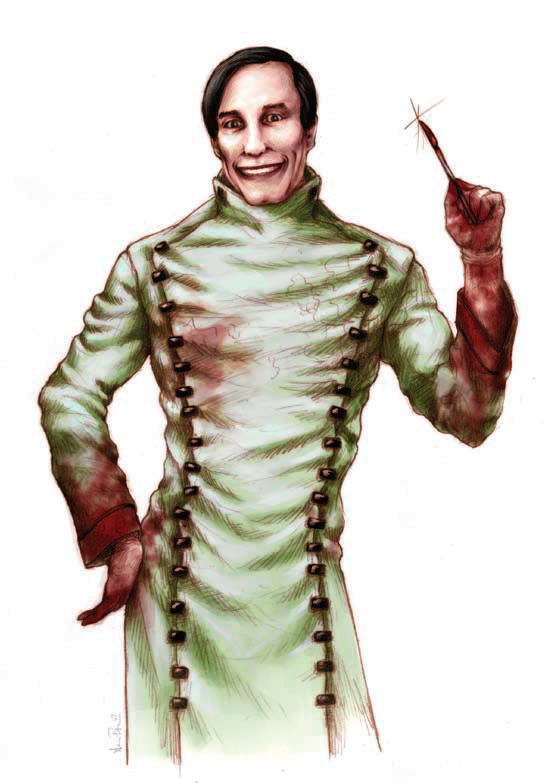
I just love this image. Yes, he's an evil surgeon, but goddamn does he love his job!
After the NPCs, there's a bunch of corporations and other groups, most of them evil to some degree, none of them all that compelling. And that's it for chapter 5, the final obstacle between us and the shit we actually care about : the rules.
Next time: We finally get to the fireworks factory, and I reveal the TERRIBLE SECRET OF ALPHA OMEGA.
Derived statistics based on other derived statistics.
Original SA post Alpha Omega Part 2: Derived statistics based on other derived statistics.Alright, after boring the shit out of everyone with the first half of the book, Alpha Omega finally deigns to let us know how the game is actually played. Turns out they had a good reason to hide it in the back.
Chapter 6: At least it's not deadEarth
Step 1: The game includes in the first step of making a character getting a piece of scratch paper and a calculator, so you know we're in for a good time. You record 500 Character Development Points, or CDP, because "Character Points" isn't mature and innovative enough, you see. From there, it's the usual, think up a concept and grab a character sheet.
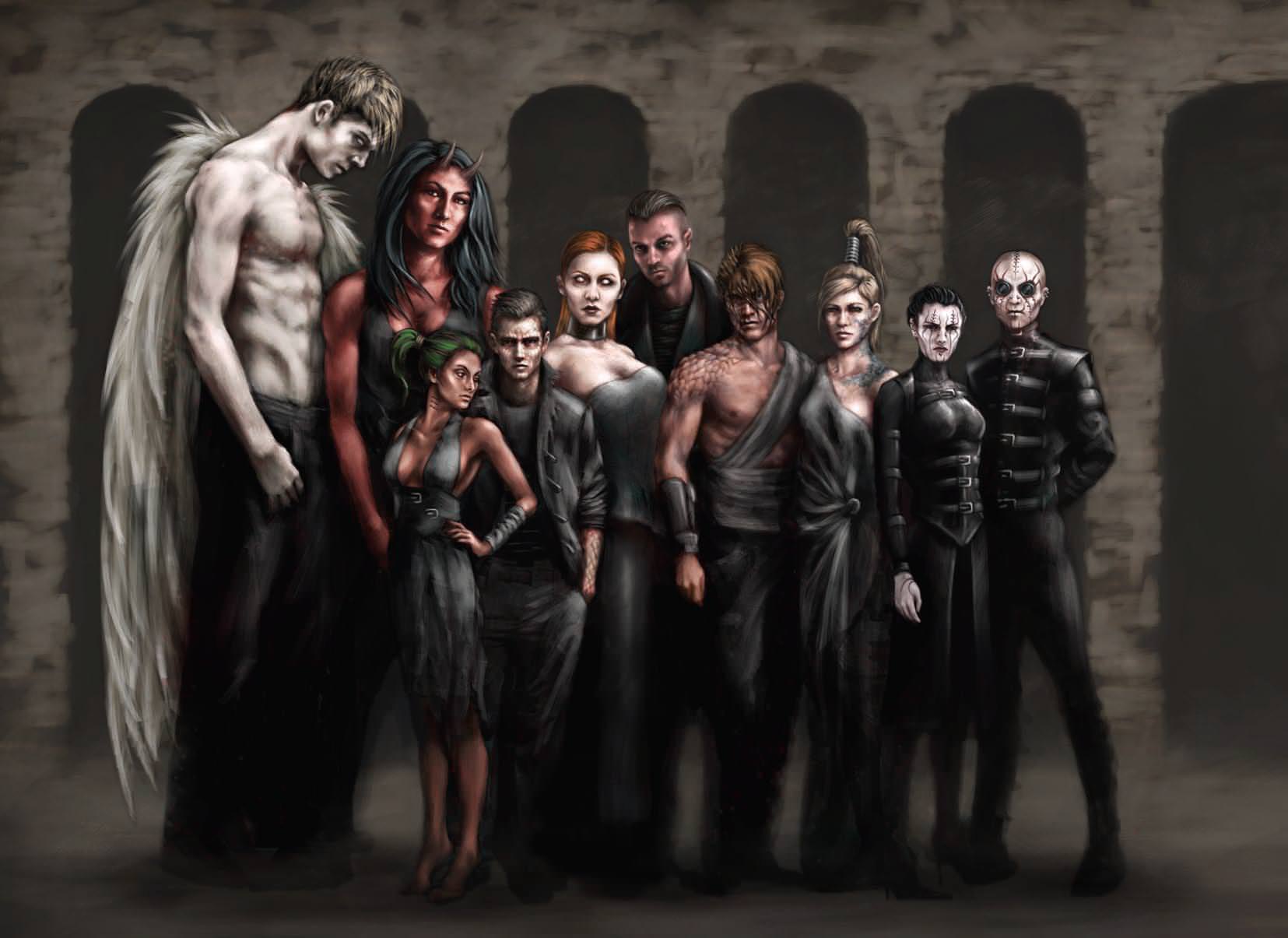
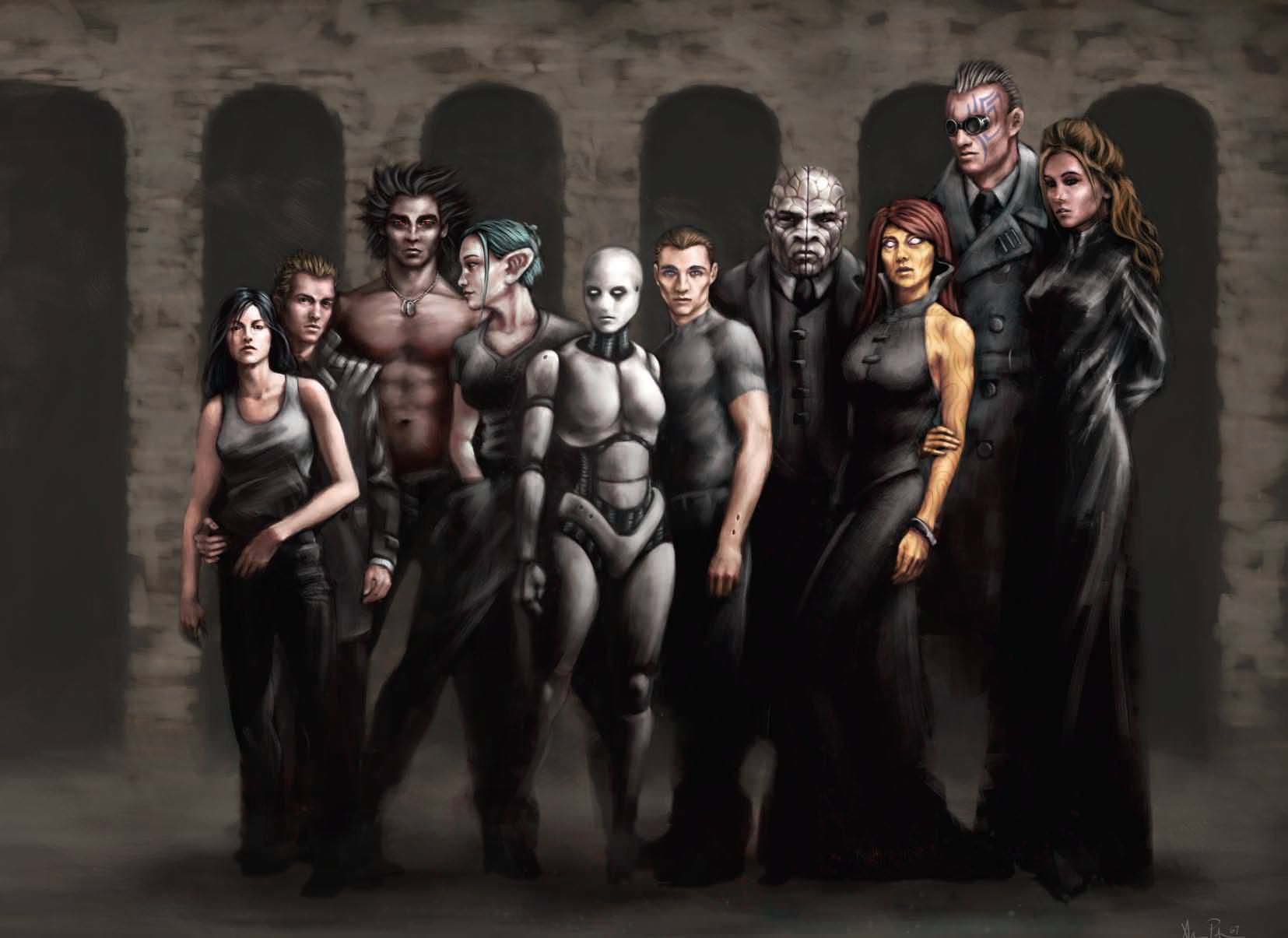
Class of 2280 yearbook photo. I feel like I wasted the "tag yourself" joke on the last post now. Fuck it, tag yourself, I'm the albino crash test dummy.
Step 2: Here's where you choose your species, and is easily the most significant choice you'll be making as you create your character. I'll be playing along with an example character, to demonstrate. But before we get into that, let's review our options for species:
-Human: Humans in Alpha Omega, rather than being simply "the average race" are actually kind of wimpy. Your Core Qualities (the AO name for your base attributes) are generally worse than every other non-human race, and merely average compared to the other human races. However, you get 100 extra points that can be spent only on Abilities (Advantages in most other games, and yes, this does sound a lot like "humans get a bonus feat at first level"), and your skills have the highest maximum ranks attainable, making humans ideal for aspiring skill monkeys. Humans also can't use Innate Wielding or the most exotic cybernetics, because they're not mutated enough to do so, and their magic is the weakest of all the races capable of Wielding, aside from the other human races, who are even worse.
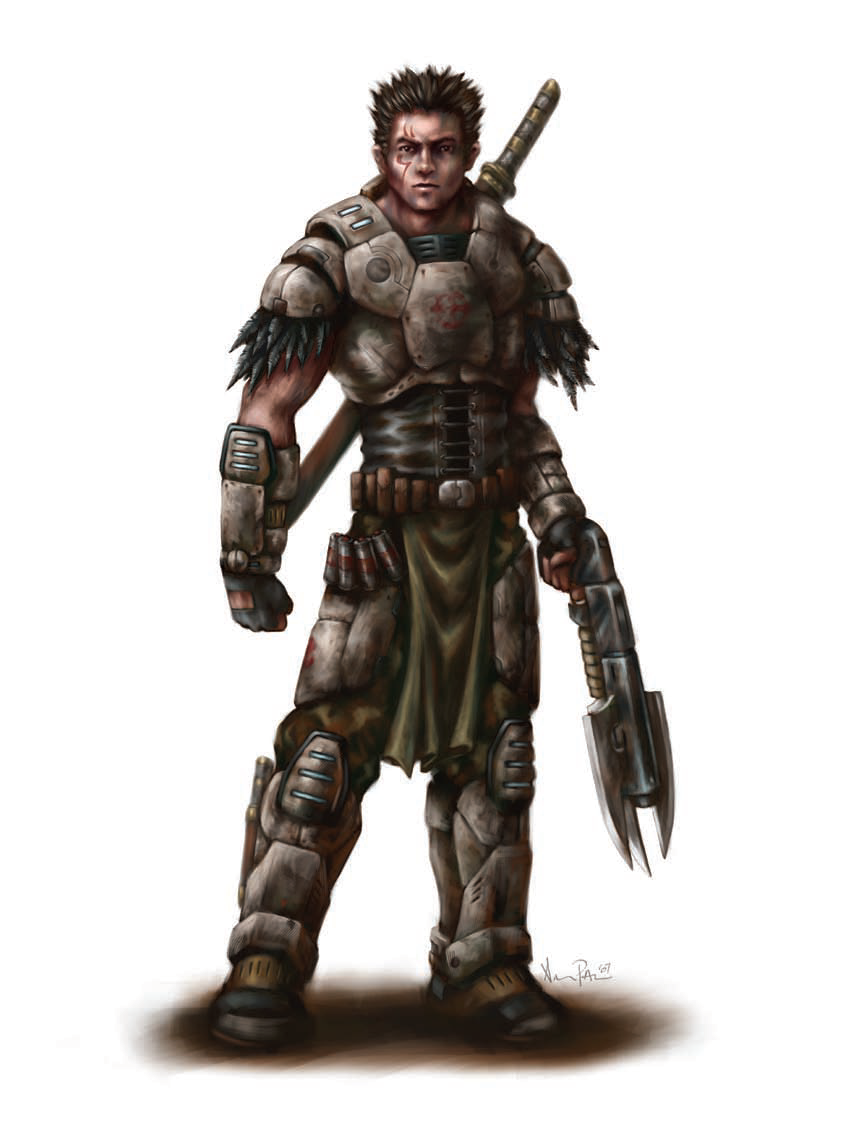
Knifegun: Almost as dangerous to your enemies as it is to you!
-Necrosi: These are humans who hid underground from the end of the world and turned into Cenobites. Their Core Qualities make them more dextrous and smarter than baseline humans, but they're a little less healthy and likeable from all the scars. They get a bunch of bonus abilities related to their sadomasochistic tendencies, as well as improved low-light vision and hearing, and even get 80 bonus points for abilities to the humans' 100. However, they have to take 80 points of Drawbacks to compensate, and take penalties when faced with bright lights or loud noises. Additionally, Necrosi have lower maximums for their skills and magic, but can make use of Necrotic Augmentations (a special form of cybernetics, basically creepy stuff most people wouldn't want in the first place, we'll get to it later). And they're still not mutated enough for Innate Wielding.
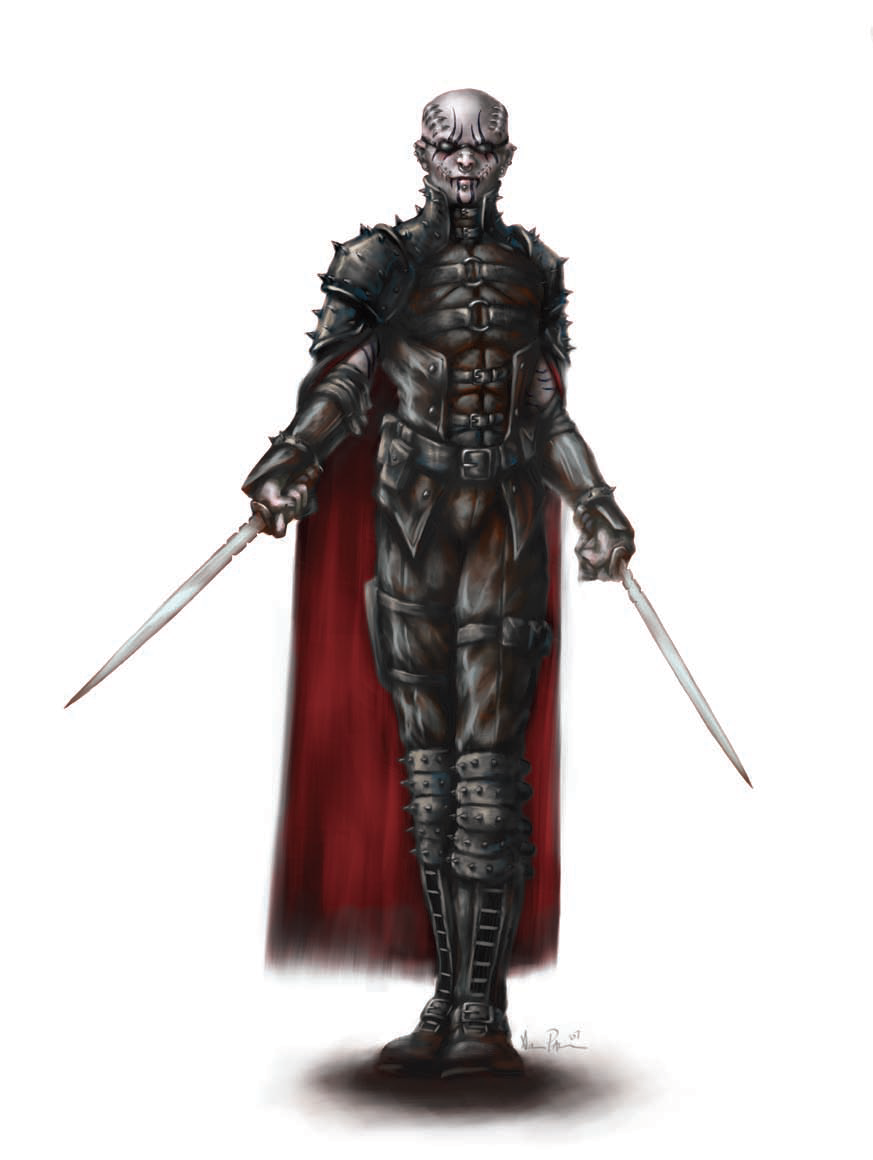
Hot Topic presents: The RA Salvatore collection.
-Remnant: Classic mutants, freaky, tumor-covered weirdos that hobbled out of the wastes when the smoke cleared. Their Core Qualities are slightly better than normal humans, but have to take 40 points of Drawbacks, and get 120 points they have to spend on Genetic Deviations (mutations). Their skill maximums are pretty low, as are their maximums for magic. However, being mutated lets them take Innate Wielding, if you don't mind being bad at it. They're also too fucked up to use Biological Augmentations (AKA bioware, in games like Shadowrun and Cyberpunk 2020), and are limited to Cybernetic Augmentations and Mesh (genetic tampering to upgrade your DNA with someone, or something, else's).
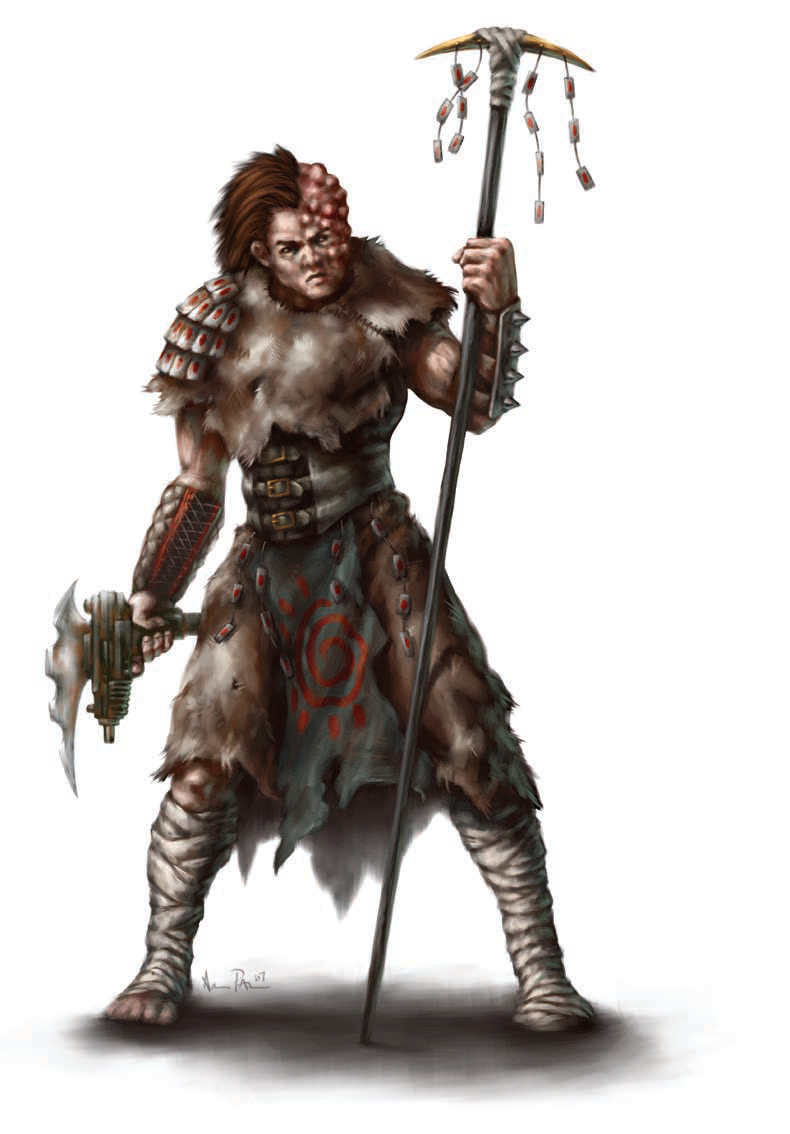
With a face like that, how could you NOT want to play as a Remnant?
-Bio-engineered: Replicants without the robot parts. They can't Wield at all, and can use the same augmentations as humans, but they're forced to spend 300 CDP buying a premade package of Core Qualities and skills, defining what purpose they were vat-grown for. This also alters their skills, as their maximums for skills considered native to their design are as high as humans, while their maximums for all other skills are extremely low. They also get free CDP to spend on their design's preferred skills, but they have to take 80 points of Drawbacks. All in all, it sucks to be a Replicant.
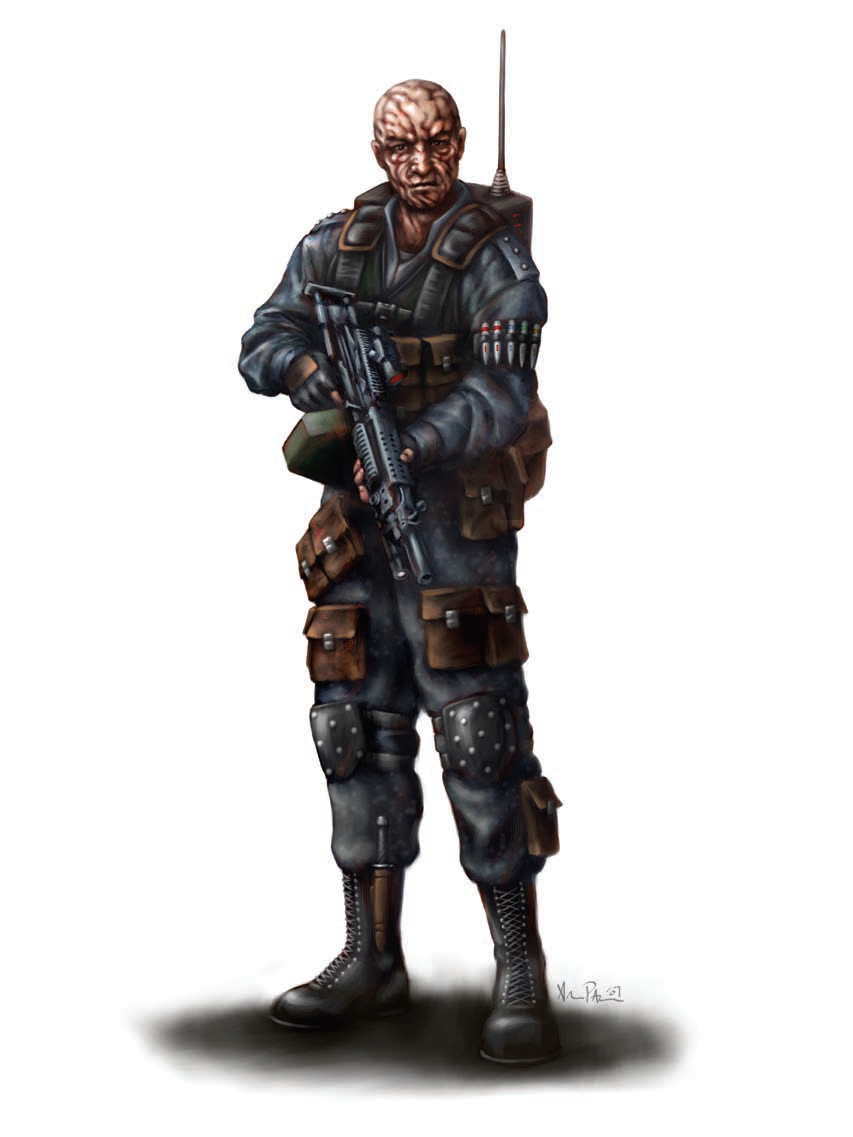
"I want you to clone me the greatest soldier money can buy, but also, could you just, like, totally fuck up his ENTIRE head? Thanks!"
-Nephilim: These are half-Elim, and come in both Seraph and Ophanum varieties. Their Core Qualities are much higher than most of the other races, they get Spiritual Wielding abilities for free, the best Wielding maximums in the game, free ranks for their Wielding, and get a bunch of free Abilities and beneficial Genetic Deviations, they start out with a free level of Ascension (more on that later), and they have access to Elim Genetic Deviations (special alien powers). However, their skill maximums are the third-lowest in the game (only half what humans get), they can't use Arcane Wielding at all (I guess being naturally gifted at magic precludes studying it), and can't use any augmentations aside from Mesh. Plus, their free Ascension has prerequisites that they can't fall below, so they have less freedom to sell off those high Core Qualities to get more CDP.
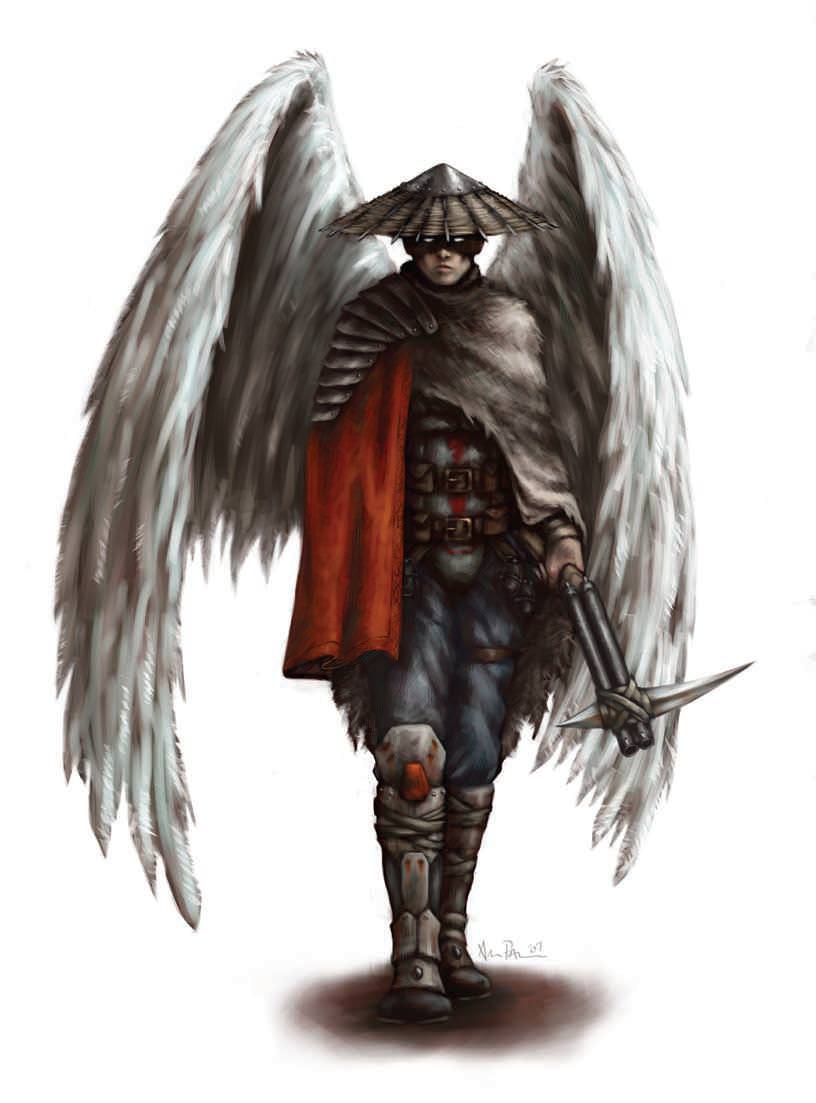
I know he looks like Raiden with wings, but I promise, you're gonna want to save the Mortal Kombat jokes for later.
-Lesser Nephilim: A half-Nephilim, or quarter-Elim. Their Core Qualities are only slightly better than humans, but their magic remains far better (though not as strong as full Nephilim), and their skill maximums are pretty low. However, they can use any augmentation they want (even Necrotic), get low-light vision for free, and get an additional 100 CDP to spend on further Genetic Deviations, not to mention access to the Elim list. It's about at this point that one realizes that nobody actually checked this game for balance, because Lesser Nephilim are just kind of better than most races. Though, given what a raw deal the Bio-engineered get, maybe it's not a surprise.
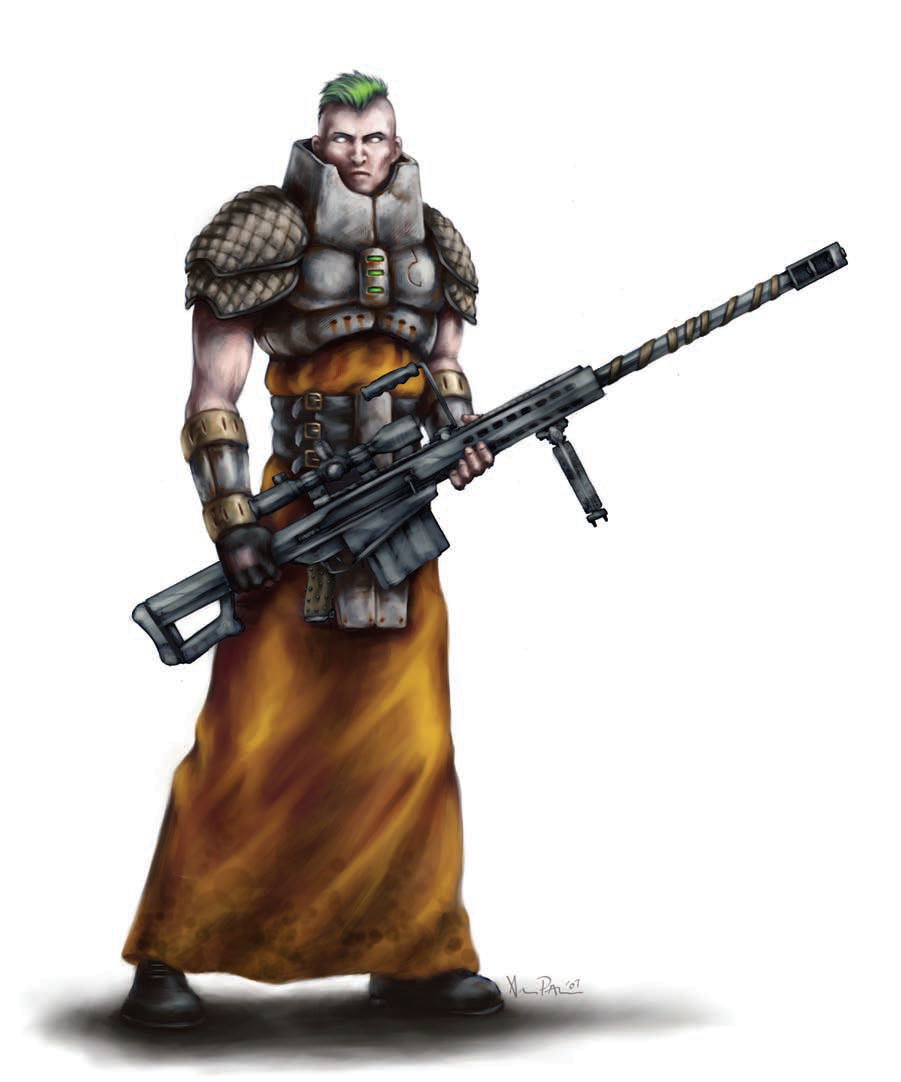
All the magic, cybernetics, and special abilities he wants, and he STILL goes for a sniper rifle. I bet the fucker spawn camps, too.
-Grigori: Despite being lab-grown by the Elim, you don't need to deal with premade skill packages here. Of course, part of this is because they have the lowest skill maximums in the game. Their Core Qualities are focused entirely on physical abilities and toughness, their intelligence and charisma are terrible. Their magic is limited to the rather restrictive Innate Wielding, but their maximums are solid, and they have unique access to the ability to State Shift (more on that in a bit). Their massive, weird bodies means they can only use cybernetic augmentations and mesh, and they're completely unable to take genetic deviations at all (outside of one particular sub-category, more later).
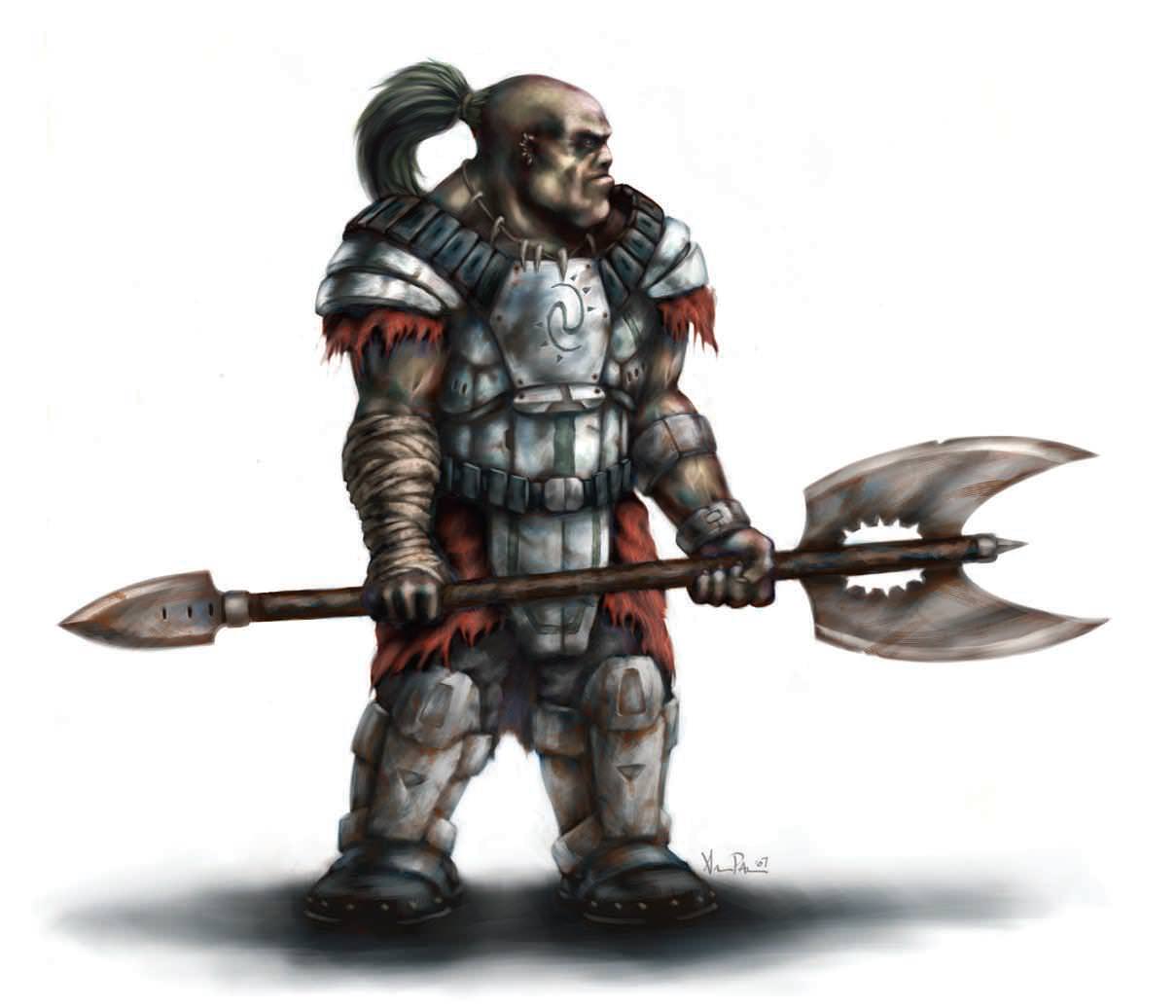
Uh, you forgot to stick sci-fi shit all over this D&D ripoff, chief. That's just an orc.
-Lesser Grigori: Like the Lesser Nephilim, but for the Grigori. They give up some of their strength to get smarter and prettier, they gain access to genetic deviations, can use any sort of augmentation, and while their skills still pretty much suck, they retain competence at magic (though they're restricted even more than the Grigori). Further, they retain the Grigori ability to State Shift, and while they're forced to take 100 points of Drawbacks, they actually get points back for taking them in this case. Much like the Lesser Nephilim, you get a feeling the Lesser Grigori get the best of both worlds.
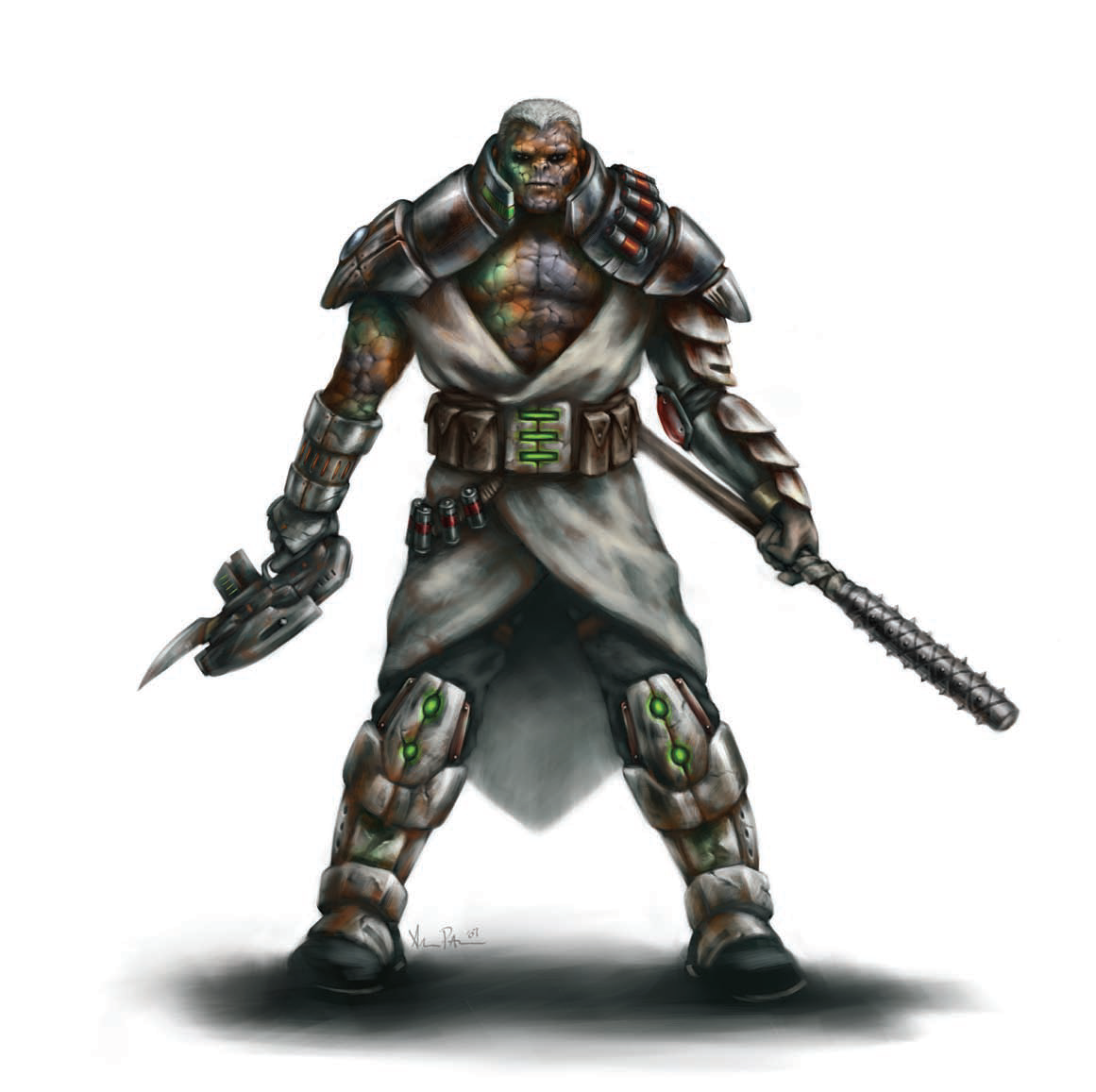
It's like some sort of unholy fusion of a Teenage Mutant Ninja Turtle and Killer Croc, wrapped in a Jedi robe for some reason.
-Anunnaki: The offspring of a Seraph Nephilim and Ophanum Nephilim. Naturally, this unholy union makes them swole as fuck, but they're not quite as strong in their mental Core Qualities as the Nephilim. They get pretty much the same suite of free Genetic Deviations and Ascension as their parents, but don't let all that bulk fool you. Their skill maximums are the second-lowest in the game, their Wielding is generally weaker (though, their Innate Wielding has more versatility), they don't get the free Spiritual Wielding (and still can't use Arcane at all), and they can't have any augmentations, not even Mesh. They're great for smashing shit and blowing stuff up with magic, and that's about it.
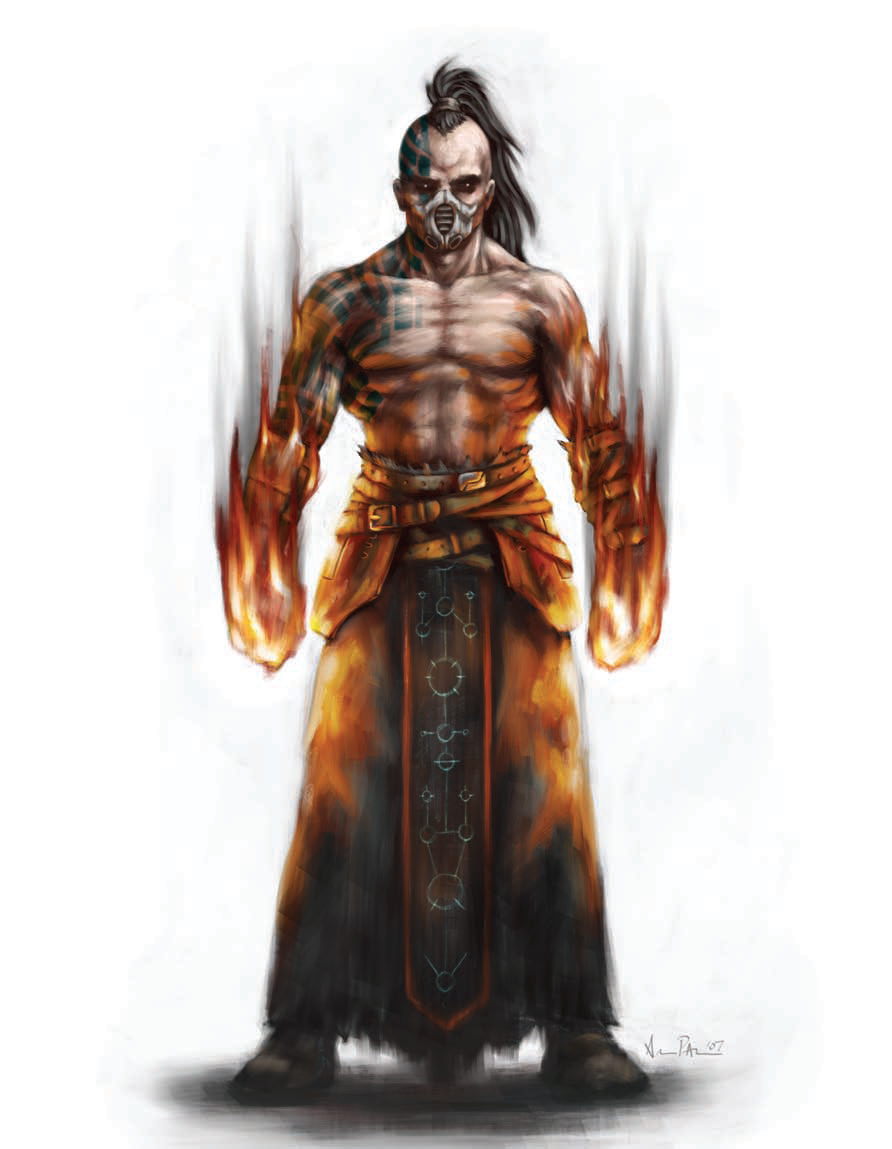
Aren't you glad you saved those Mortal Kombat jokes? Toasty!
-Artificial Intelligence: Robots and androids. Now, most races have maximums for their Core Qualities that they need to raise by spending CDP to break their race's limits and evolve to the next stage of blah blah blah. Robots can pump their stats straight to 100 right out of the gate. At first, it looks like their Core Qualities start out lower than every other race, with 9s across the board (humans begin with 12s, Anunnaki go up to 20 with some of them), but robots get a pool of 50 points to spend 1-for-1 to raise those bases up. Naturally, they can't take any Genetic Deviations, nor can they Wield at all, and they're limited only to cybernetic augmentations (though they can take twice as many of them as meatbags). Their skill ranks can also hit the true maximum, like humans, and they get free skill ranks to begin with. Also, they're immune to a bunch of stuff like hunger, disease, poison, and so on. Sure, they can't take Ascension levels, but who needs 'em when you've got a howitzer for an arm?
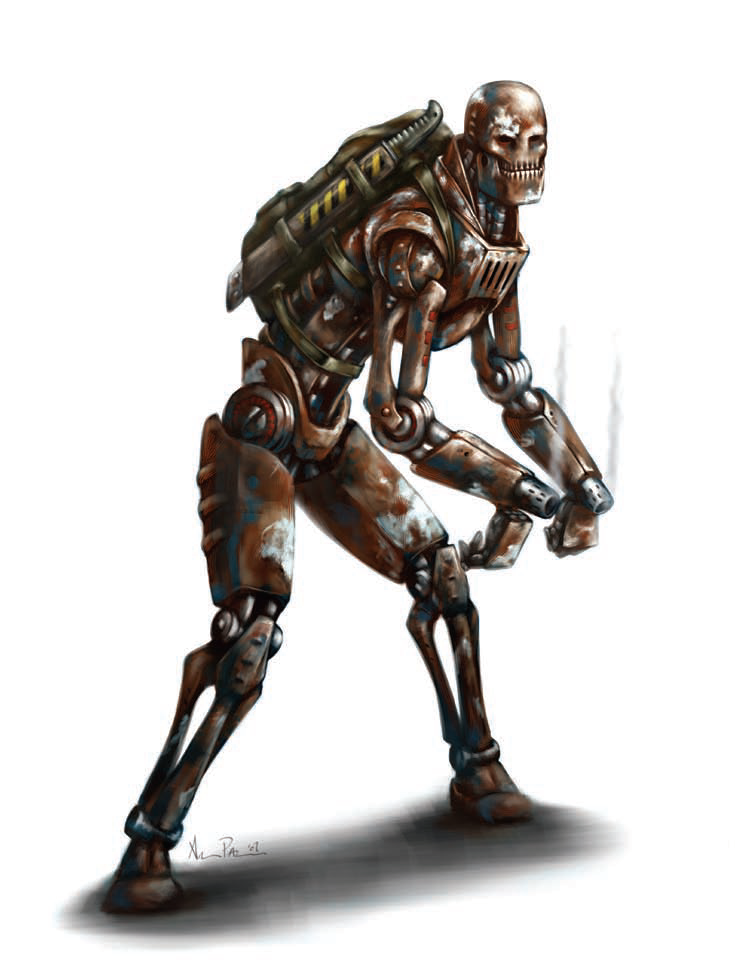
This one kind of owns tbh. I'd totally play "rusty, skinless T-800 with SMGs in my wrists and a handy rucksack just because".
Alright, so these are our choices. For my example dude, I'll take a Lesser Nephilim, since they're easily the most versatile species, with access to basically everything. This starts me with 13s in every Core Quality, and racial maximums of 22.
Step 3: Now it's time to adjust my Core Qualities. It's recommended that I not spend more than 100 CDP here, but I'll be sure to spend a few, so you see how it works. Let's have a look-see at our options. One interesting note is that your height, rather than altering your Strength directly, just applies a modifier to how much weight you can manage. Anyway:
-Strength: Alters how much you can carry, and affects melee combat in an unspecified-as-yet fashion. I'm thinking my Lesser Nephilim will be more about fighting at range, using magic and possibly guns, but I like the idea of just being able to dunk all over humans just because, so I'll just leave it as-is.
-Agility: This helps with aiming, stealth, balance, and the Reaction Tertiary Quality. Tertiary Quality? Now if that ain't ominous. Well, so far, so obvious. I think I want a couple points here, so, let's refer to the chart that tells me how many points it costs to raise a Core Quality within this range. So, I'm in the 11-15 range, so it's 15 CDP per point. I'll spend 30 CDP to get to 15 Agility.
-Conditioning: Ah, now we're into it. This represents fitness and stamina, basically how long one can keep up strenuous activity. I'm good with my decidedly-above-average 13.
-Vitality: This one's a measure of my inherent health and vigor, which contributes to my Health Pool (HP), and my ability to resist poisons, disease, etc. Again, 13 is a solid starting score, so I'll leave it for now.
-Discipline: Mental fortitude, it also seems to contribute to my endurance, like Conditioning, but it also improves my saves against fear. Not bad, but no need to spend a lot of points right away.
-Intelligence: Higher Intelligence will give me a scaling discount to the cost in time and "trust" (presumably the willingness of NPC teachers) to improve my skills and Wielding during play. I'll need a 16 to hit the next break point on that scale, and getting from 15 to 16 on a Core Quality costs 20 points, rather than 15, but still, I think it's worth the 50 points to get up there. I want my guy to be smart, anyway.
-Charisma: Charisma is, as usual, likeability. I've already spent a fair number of points on my Core Qualities, and they were solidly above-average to begin with, so I'll leave it as-is for now.
Okay, so that's it for-oh wait, now there's Secondary Qualities.
Step 4: Secondary Qualities:
-Athleticism: This is the average of my Strength and Agility, and affects physical skills and melee damage. With a 14, I deal +1 melee damage. Woo.
-Physical Acumen: The average of Conditioning and Agility, this affects ranged damage and other physical skills. Another +1 modifier to damage.
-Fitness: Another physical trait, this time the average of Conditioning and Vitality.
-Will: This one is the average of Discipline and Vitality, and affects one's focus and ability to resist outside control.
-Wisdom: This is the ability to discern the truth, made from the average of Discipline and Intelligence.
-Wit: This is quick thinking, and averaged from Intelligence and Charisma.
-Presence: How physically imposing I am, using the average of Charisma and Strength.
Okay, I've calculated all that, so now I-oh fuck, right, the Tertiary Qualities!
Step 5: Tertiary Qualities:
-Reaction: Reaction is basically initiative, and determines which segments of the action cycle I act in and oh dear I do not like the sound of that. It's the average of Athleticism and Wisdom, rounded up. Wait, so my Agility only contributes to one-fourth of my Reaction? Why did the book emphasize its effect on reaction, then? I suppose because that's because Agility doesn't do much else.
-Physis: The average of all my Core Qualities put together. This is apparently a measure of how high up I am on the evolutionary ladder, and based on what was said back in the section on robots, it also determines how much cyberware I can shove into my body. It looks like it's also used to resist certain Wielding effects and death.
-Endurance: This is a pool of points I can use to get minor boosts or pay for certain kinds of Wielding. It's just the sum of my Conditioning and Discipline.
-Movement Rate: This is based on my Athleticism, and the chart for that is found in the next chapter. Guess it'll be a surprise!
-Defense: This is my ability to passively defend myself, and it's half my Reaction. Looks like it has a lot of uses.
Step 6: Okay, now that that's done, it's time to calculate my Health Pool, which is, I guess, a Quarternary Quality? That's the sum of my Conditioning and Vitality, so that's easy enough to figure out.
Step 7: Okay, abilities and drawbacks, this ought to be fun. Odd that I haven't seen the skills yet, though. Now, I'll want to keep some points available to purchase Wielding later, so let's see some options. I'll start with Good Memory for 60 CDP, moving my costs for learning new skills down two steps on the chart and providing a bunch of minor bonuses in tricky situations. Then, I think I'll go with Fast Learner, to halve those costs, reducing my overall cost for learning to something pretty negligible. Then, let's take Citizenship for 20, the benefits of citizenship look pretty massive compared to the low cost. And while I'm at it, let's make sure the GM can't spring any nasty surprise storms on me and take Sense Weather for 10, to let me feel oncoming weather in m'bones.
Now, for drawbacks, I could take Exiled to gain 150 CDP and just say I was exiled from a city-state on the other side of the globe, but that's clearly a scummy way to go about it. I'll take Bad Driver for 20, and One-hand Dominant (taking a larger penalty for actions with my offhand) for 50, leaving me with 300 points for other stuff.
On the way out, let's have a look at State Shifting, the Grigori's special ability, because it's part of this step for some reason. So, it looks like a fair amount of information vital to this is found in the next chapter, but it seems the Grigori can alter one of seven states for themselves or, sometimes, others: Size, Speed, Fear, Density, Disposition, Thought, and Emotion. Buying the ability to alter those states costs 200 CDP, each, and the number of states you can have, as well as how many points you get for shifting them, are based on your Physis. Even getting two states requires you to break the maximum stat limits, and even with 100 in every Core Quality, you can't have more than 4 of them. It seems that Grigori can only alter other people's emotional states, the Speed, Size, and Density State Components only work on themselves. So, depending on target, duration, and intensity of the effect, State Shifting costs a varying amount of points, but it's multiplicative, so it likely gets expensive fast if you start trying to scare bad guys. It's kind of shitty and not exactly well thought-out.
Step 8: Alright, Genetic Deviations, I got a free 100 points to spend on this stuff. So, first up, I get low-light vision for free. Now, the first portion of the deviations are just upgrades to basic bodily systems. Since Wielding apparently takes endurance, I'll take both levels of the Respiratory System upgrades, to gain 20 additional Endurance, for 80 points. And since I can take Elim deviations, I'm going to take Wings and fly, dammit. They're 100 points, but they're worth it. Okay, 220 points left. Fuck it, it's Alpha Omega, I'll go back and take Exiled, jump back up to 370.
Step 9: Alright, on to skills. Looks like skills are split up into broad fields, broken up into individual skills. Putting ranks into Fields represents broad, general knowledge about all the related skills, while having ranks in a specific skill represents specialized knowledge. Right now, I can only buy up to 4 ranks of any field or skill. Looks like any Field would cost 30 points per rank, and skills cost 10. I'll take four ranks of Concentration from the Alertness field, as it's required to maintain Wielding under duress. From there, I think my character is more of a scholar than a man of science, but I'll take four ranks of Arcane from the Science field to represent his study of Wielding, as well as two points each from History and Theology from the Arts field, plus one rank of the Arts field itself. I'll finish up with 4 ranks in the Pistols and SMGs skill in Small Arms, for a total of 190 points.
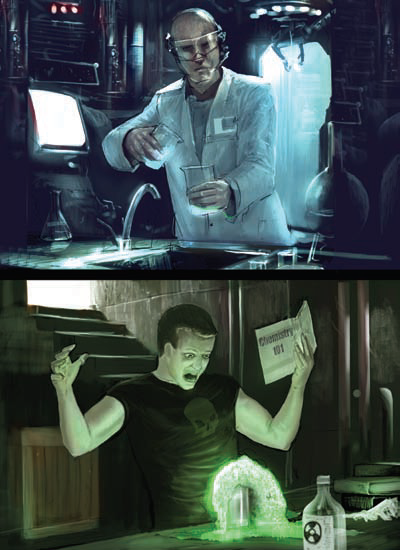
The example image for the Chemistry skill is just a Goofus and Gallant cartoon.
Step 10: Finally, what we've all been waiting for, magic! I have 180 points to spend, I may have to swing back to previous sections to shore up my points if I want a cool wizard. In fact, that's just what I'll do. Not only was I Exiled, but I'm Wanted and have a Price on my Head, for 260 additional points. I'm a baaad man, baby!
Okay, now that I'm flush with CDP, let's go hog wild, and take all three Wielding types, seeing as Lesser Nephilim are one of only two species that can do so. So, 80 for Arcane, plus 20 to get a required first rank in a Source and Intention, 50 for Innate, which, based on my race, gives me one free Source and two Intentions, all at rank 3 for no extra cost. For Spiritual, I have to choose whether to use Alpha or Omega. I think I'm more of a rebel with a heart of gold, so I'll go with Alpha. So, let's see what all I can do here, starting with Intentions, since there's a whole sixteen of them, split into four groups, and each Intention can only be used with certain Sources. I'll have to skip ahead to chapter 7 to see them, but in this case, I have no choice.
-Sancto: This set of Intentions seems mostly geared towards helping people. Deliverance can heal wounds, cure disease, and so on, and can only be used with the Being, Alpha, and Omega sources. Salvation can be used to make protective barriers, and works with the Elemental, Energy, Void, Alpha, and Omega Sources. Creation can be used to make matter or energy, including illusions, and works with all six Sources. Inspiration can instill courage or provide skill bonuses to allies, and works with Energy, Being, Alpha, and Omega.
-Bane: The Bane Intentions all seem to be the opposite of Sancto's. Agony is used to inflict damage, using the Elemental, Energy, Void, Alpha, and Omega Sources. Damnation debuffs enemy defenses, using the same five Sources. Nihilism is used to destroy non-living matter and illusions, using Elements, Energy, or Void. Malice fills enemies with fear and doubt, fucking up their rolls, using any Source except Void.
-Order: Order Intentions are a little more high-concept, dealing with constants and the known. Constancy can extend durations, prevent or redo random rolls, and alter the size and shape of stuff, using Void, Being, Alpha, or Omega. Clarity clears up confusion and lets people see through illusions, using Elemental, Being, Alpha, or Omega. Insight can let you read minds or block mental effects, using Elemental, Void, Being, Alpha, and Omega. Control can telekinetically move matter, take control of summoned creatures, keep people calm, or alter someone's appearance, using Elemental, Energy, Being, Alpha, and Omega.
-Chaos: Like Bane opposes Sancto, Chaos opposes Order. To save you some time, the intentions are Entropy, Insanity, Ignorance, and Anarchy, each opposing their equivalent Intention in Order.
Hm, for my two free rank-3 Intentions, I'll take Deliverance and Agony, then spend 20 points each leveling them to 4. For an introductory Intention for Arcane Wielding, I'll just spend 30 get Control at 3. And sure, I'll take Creation at 3, to represent my Spiritual Wielding. Now, for Sources.
-Elemental: Wielding with this Source manipulates the Greek elements of earth, fire, water, and air. That sounds pretty powerful. That said, the success or failure of Elemental Wielding is based off of Conditioning, which I'm not really focusing on with this character.
-Energy: This Source controls all energy, including electrical, photonic, and kinetic. Energy also uses Intelligence as its Core Quality for Wielding, so I've got an edge with it.
-Void: The Void Source is all about negating or erasing stuff, and seems to be the primary Source for dispelling opposing Wielding effects. Its Core Quality is Discipline, which I'll probably raise later on, as I gain more CDP.
-Being: This is the Source that lets one directly affect living matter. I can't heal people without this Source, looks like, so of course I want it. It's based off of Charisma, another Core Quality I was thinking about raising.
And now, the moment you've all been waiting for:
What do the Alpha and Omega sources do that's so important that they share their name with the title of the game?
-Alpha/Omega: They work with almost every Intention, but only affect ghosts made of Alpha and Omega energy; they're incapable of affecting physical matter.
That's right. The titular goddamn options, and they're completely useless the vast majority of the time.

Guess that explains why Spiritual Wielding is so cheap. They're based off your Will, making them the only Sources based off a Secondary Quality. So, fine, let's take Energy as our free rank 3 and pay 20 to put it at 4, then another 50 to bring Being up to 4, and 30 each to bring Void, Elemental, and Alpha to 3.
And we're done! All that's left is a name, picking out spoken languages, and other minor stuff. Well, there's equipment, too, but all of that is next chapter. So far, Alpha Omega has been largely just bland and forgettable, aside from making the "holy" magic of the game completely worthless and generally being too goddamn complicated for its own good. But that's because you don't know what all these numbers do yet.
Be afraid. Be very afraid.
Next Time: The assassination of dice by the coward Mindstorm Labs.
Bonus: Other skill example images, because Mindstorm Labs actually had a pretty solid sense of humor about them.

This is for the Gather Information skill. Told you that robot was cool as fuck.
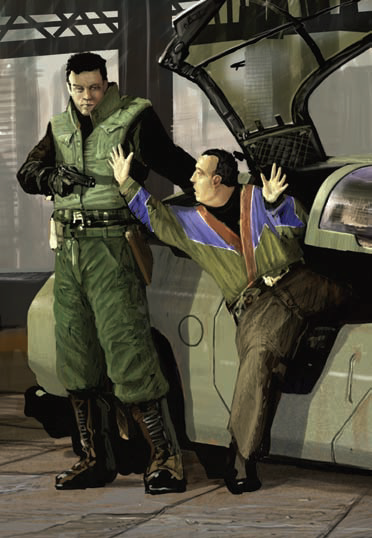
Theft. I'm not sure that's how that skill works.
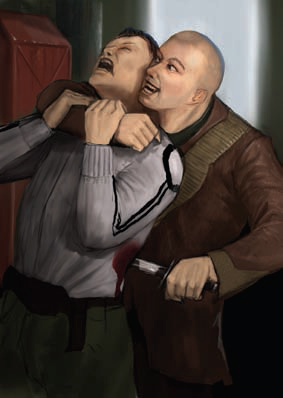
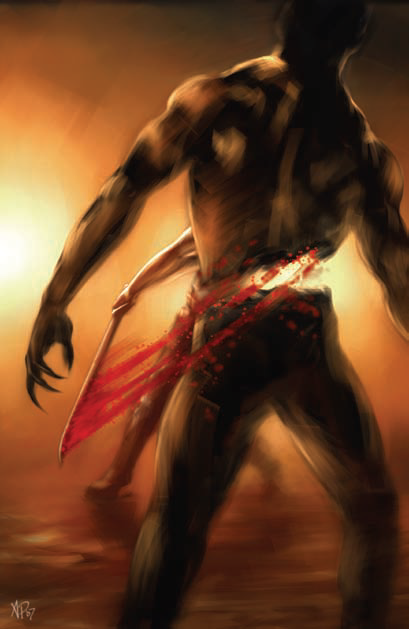
One-handed Melee vs. Two-handed Melee. Pretty sure this is another Goofus and Gallant, but I couldn't tell you which is meant to be which.
Wait, do WHAT with my dice?!
Original SA post Alpha Omege Part 3: Wait, do WHAT with my dice?!Here it is, the chapter that basically makes this game worth mocking. There's other dumb stuff later, but this is where the game really starts to break down. Though, one small note about the title, it's worth mentioning that the Seraph are generally associated with Alpha energy, and Ophanum with Omega, but it has zero mechanical effect besides giving you an easy way to predict which Source the aliens are going to be Wielding if they encounter a ghost. So, still basically useless.
Chapter 7: Dice Crimes
The chapter begins with a glossary of game turns, and then immediately starts up telling us about Alpha Omega's dice pools. Which dice do you roll? Well, let me just show you the chart:
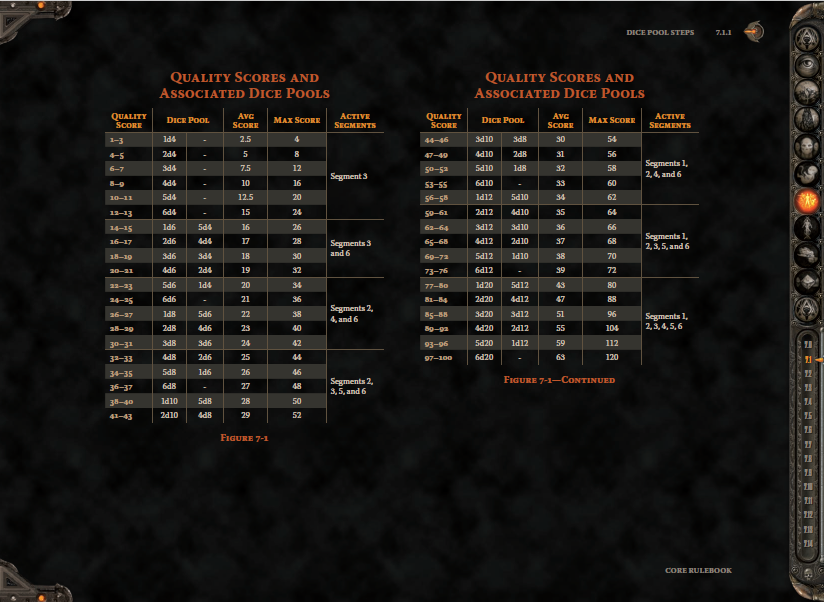
By the way, yes, this is the color scheme for every chart in the book.
So, let's break that fucker down. So, you might think that your Quality Score is calculated by adding your skill or Wielding ranks to their governing Core or Secondary or Tertiary Quality, right? Wrong! Only your Core/Secondary/Tertiary Quality goes into your Quality score, your skill/Wielding ranks proved a flat bonus to the roll. So, for example, if the character I built in the last post wants to roll Theology to pray to a merciful God to save him from this goddamn chart, he'd be rolling 1d6 and 5d4 (his Wisdom is 15), then he'd add 2. For most tasks, he'd be rolling 6d4 and adding nothing. By the way, you may now be thinking to yourself, now that the chart is revealed, aren't the races with shitty skills but high Core Qualities actually just better at both because they roll much larger dice pools? Yes, yes they are. Sure, they lack the consistency provided by skills, but, and I apologize for not going over this last post, but there are dozens of skills, which you'd have to raise individually. Oh, and you'll want to add Field ranks, too, because those add to every skill within the Field. Or you could just roll more and bigger dice.
So, what can we do with our dice pool? Well, let's check the chart of Difficulty Ratings for checks. A "simple" task is DR 10, "easy" is DR 20, "average" 30, "difficult" 45, and "formidable" is 60. Now, wait just a moment, our absolute best roll for any skill is 1d6+5d4+4. 30 is literally the highest number that we can reach with that. It takes a perfect roll just to beat an average skill check for most starting characters. Even the vaunted Nephilim and Anunnaki are only working with the 18-19 and 20-21 rows of the chart on their best Qualities, starting out. And note that starting PCs are supposed to be above average compared to normal people in this game. Normal people can barely handle Easy shit. Oh, and that's not all. The first time you make a skill check, you also roll the Critical Die. Basically, you roll a 1d20 alongside your dice pool. If it comes up 20, you get a Critical Success, if you get a 1, Critical Failure. Why the fuck are we just rolling a d20 solely to see if criticals happen? Don't ask me, that's a DR 30 check.
Now, aside from Skill rolls, there are also Resist rolls, basically saving throws, and while they use the same dice pool, their DRs are much more lenient, with average being a mere 15. At least you won't get murdered by save-or-die spells. But that's enough about skill checks, let's move on to other systems that are entirely too goddamn complicated.
The next section of this chapter begins by describing how the game tracks time differently in and out of combat. It includes the deeply concerning line, "Success checks (their catch-all term for rolling your dice) undertaken during Standard Time always have the advantage of a whole Dice Pool, meaning players roll all their available dice." No further explanation is given for that during this section. Instead, we move on to Stances. I'm just gonna put up the chart again for this:
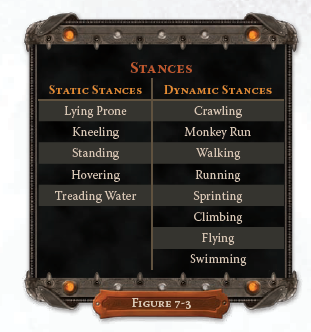
Yeah, this is gonna get worse before it gets better.
So, first, let's discuss the difference between Static and Dynamic Stances. In Static Stances, you can't move, while in Dynamic Stances, you must move. You can only change your Stance at the start of a turn, as a free action, either between valid Static Stances, or from a Static Stance to one of its corresponding Dynamic Stances. You see, you need to be in the right Static Stance before you can switch to a Dynamic Stance. And you can't move between Dynamic Stances, either. Yes, this means that in order to go from Running to Sprinting, you have to first come to a complete stop, as you can only initiate Sprinting from the Standing Stance. Oh, except here, literally one paragraph after saying Stances can only be changed at the beginning of a turn, it says you can go from a Static to Dynamic Stance at any point in the turn you want. Get those editors, kids! Presumably, they mean you can downshift from a Dynamic Stance back to Static at any point in the turn, basically, you can choose to stop moving whenever. As you may have guessed, each type of movement has its own movement rate, which is also modified by Athleticism, remember that? Now, my average starting PC Athleticism only lets me move 2 SIM on the ground ("SIM" is Alpha Omega's universal measurement, equating to one grid square, one inch on the table, or one real-world meter, depending on how you play; this is literally the one really well-implemented part of the rules), but I got wings so fuck that I'm gonna fly, which lets me move 10 SIM right off the bat.
Oh, and remember how this game supports a no-miniatures style of play? Character facing is an important mechanic. Have fun constantly checking with the players to figure out which way they're all facing!
Next, we get on to Creature State, where we can finally learn about that shit Grigori can maybe do once they've gained a couple thousand CDP and raised their Core Qualities enough, or that Wielders can change pretty much right out of the box. I'm... I'm just gonna post the charts.
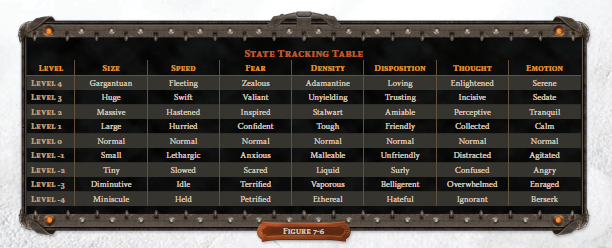
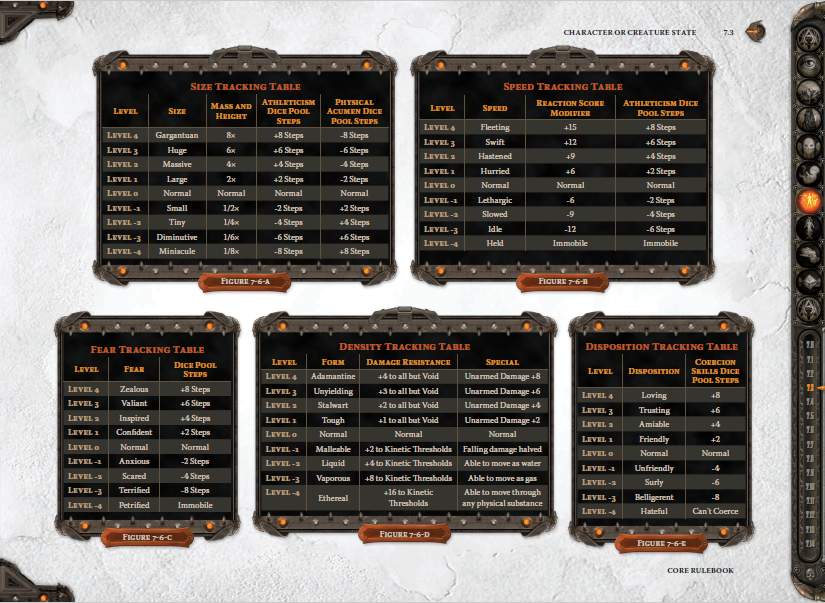
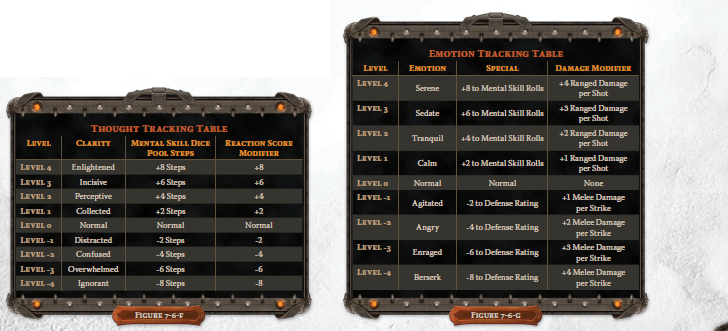
This is all extremely necessary.
Moving on at top speed, we finally reach the full, formal description of how to use skills. First, we're told to calculate our Skill Proficiency Level, or SPL. Don't panic, it's just the sum of our Skill and Field ranks. Skill checks are described as a "simple four-step process", so let's see how simple it is. First, declare an action, easy enough. Next, the GM assigns a DR to your action, hopefully you picked something easy. From there, you determine your dice pool (yes, that chart gets used for basically every roll you ever make, because if you get any sort of circumstance bonus/penalty, the GM is told to adjust your roll by steps on the chart rather than raw numbers). Then you roll, but, let's take a look at how Alpha Omega describes rolling:
Alpha Omega posted:
The player rolls the Dice Pool and the sum of the roll is added to the character’s SPL for that Skill. This total is referred to as the character’s Attempt. The Attempt is compared to the DR of the Skill Check. If the Attempt is greater than or equal to the DR, the player is successful, and if it is less than the DR, the player is unsuccessful.
This is the sort of bullshit I've been sparing you people by summarizing everything, everything in this book is written just like this. You're welcome. Further rules are given for using multiple skills at once, helping each other out, and modifying the DR for when you need to hurry up.
Chapter 7.5: Fuck it, new header because now it's time for the combat system. Hold on to your hats.
Fortuitously, the combat section is section 5 of the chapter and denoted as "7.5", so that's convenient for me. This is where we meet the "6-6 System". I've been saving this explanation. See, the "6-6 System" was apparently such a big fucking deal to Mindstorm Labs that they got a separate copyright for it, and even made a logo for it. Because this was gonna be the next fuckin' OGL or some shit.
How's the 6-6 System work? I'll let the creators explain:
Alpha Omega posted:
REMEMBER THE CYCLE 6-6 RULE. There are 6 Segments in a Cycle, and characters can only roll 6 dice per Cycle for the Actions they initiate. Dice used for Reaction Checks, Resist Checks, or any other rolls not initiated by the character are not deducted from these 6 dice. If a character has more than one Active Segment in a Combat Cycle, which is the case the majority of the time, the player must decide how many dice to roll in each Active Segment.
In other words, remember those dice we have that are barely sufficient to handle the simplest of tasks? Now we might have to split them up. Referring back to the original chart, we can see that our Reaction entitles us to actions in both Segment 3 and Segment 6, but our odds of being able to accomplish anything if we try to act in both are pretty fuckin' low. Each segment represents one second of a six-second turn. By the way, if that sounds at all familiar, it's because it's basically using D&D turns to handle 7th Sea-style initiative, but also you have to divvy up your ability to be competent between each action.
This explanation is followed by overly long explanations of initiative, surprise rounds, and the various action types, it's nothing you haven't seen before, just written by people who think "more words" equals "more smart". Turns out the only effect character facing has on gameplay is increasing the penalty you take for shooting at multiple targets based on how much you need to turn before you're facing them. From there, it goes into damage, death, healing, and so on. It gets mildly interesting when it hits the section on Endurance. You can use it to boost physical actions or speed up your Wielding, but you take scaling penalties to your dice as you start running out, so basically you can't use the last 30 percent of your Endurance pool if you want to live. After that, it's back to normal shit. Lighting and darkness, the effects of drugs and addiction, poison, disease, fall damage, and exposure.
Now, the driving rules are kind of fun, because they're technically impossible to use. There's a misprint on the chart for calculating the difficulty of making tricky maneuvers while driving. Where the numeric modifiers for velocity would go, it instead lists the Qualities used for the different Wielding Sources. The only indication that you're not supposed to somehow add your Charisma to the Maneuver Rating of your maneuver (which then translates into a DR on a sub-chart) just because you're going at less than 25% of max velocity is that the example text uses a flat number as the modifier for Max Velocity (and also because the other way is stupid). Granted, it's easy to intuit from the example that the misprinted section just goes 0, 2, 4, 6, 8, but for a game with such a love of charts, they really fucked this one up.
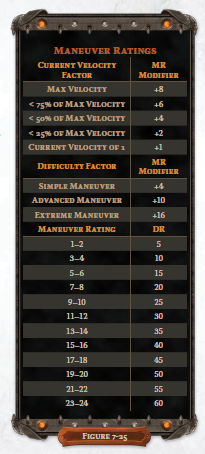
WHOOPS.
EDIT: So, as you might notice, I fucked up a little! So, I just grabbed that chart from my PDF without looking, it turns out that in the PDF version of the book, they fixed the misprint! My physical copy of the book is what I was actually reading through, so, uh, sorry!
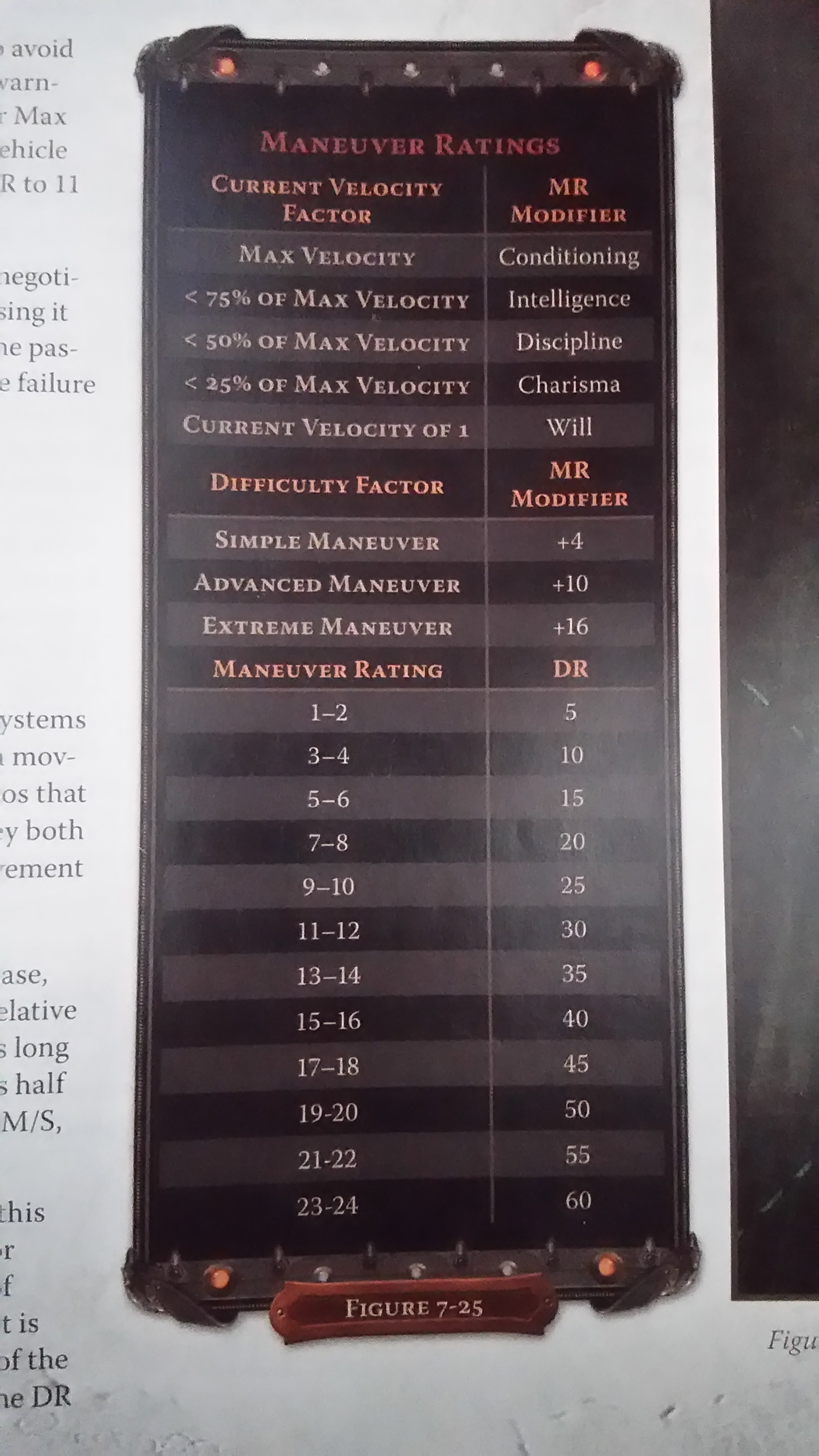
The actual misprint in question. I'm not crazy!
Finally, the book explains Wielding. We've already read about what the Sources and Intentions do, but how do we use them? Well, you build your effect using the following factors:
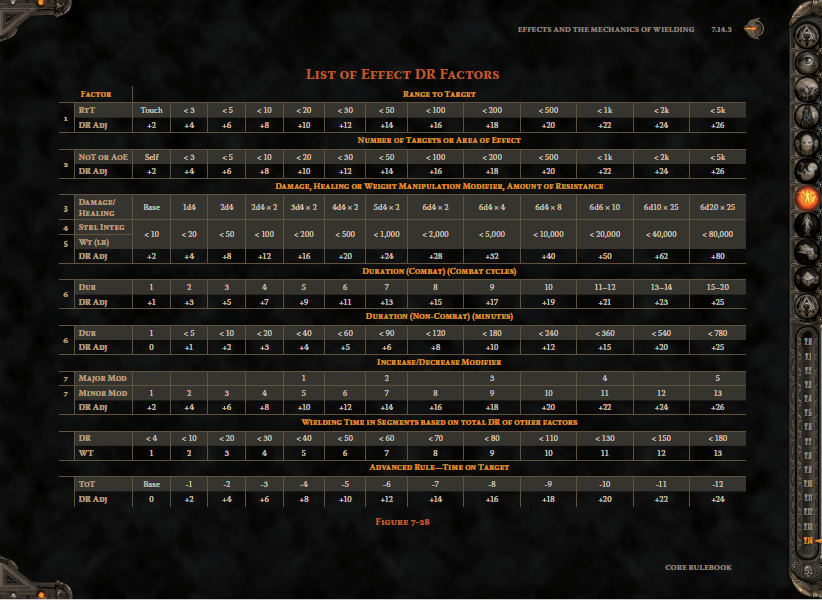
Yeah, it's as bad as it looks.
So, let's go through what those mean. So, first is the range, which only factors in the distance to the furthest target you're trying to affect. Then, you get your number of targets or the diameter of an AoE you're making. Next are the damage/healing you're trying for, or the the structural integrity of a shield you want to erect, or the mass of an object you want to move. Next are the durations in combat and non-combat measurements. Then, you get to the modifiers. Minor mods affect Quality Scores and non-combat durations of things, while Major mods affect basically everything else, and are also used to create matter and illusions with the Creation Intention. At the bottom, you see the casting time is based on the DR, and you can take additional increases to the DR to reduce the number of segments you need to spend casting (don't worry, the book does state that these increases are not themselves factored into the Wielding time). Also, you need to spend Endurance equal to the Wielding Time of the spell, because casting is hard work.
From there, you roll it like a skill check, but using the sum of your Source and Intention to calculate your Wielding Proficiency Level (WPL). If you fail, you still Wield, but bad shit happens. If you fail by less than 10, the GM rolls 2d8 to determine which of the seven factors of your spell got altered, and to what degree (yes, this means that you can end up creating shields or doing damage/healing despite not even being able to do those things with the Source or Intention you're using). From 10 to 25, not only does your spell fail entirely, but you lose double the Endurance cost, and take irresistible damage equal to that. Fail by more than 25, and it's quadruple. With my Lesser Nephilim's 26 Health, it would take a spell with Wielding Time 7 to instantly die from a catastrophic failure, but there's nothing stopping you from trying to max out every factor and just popping yourself like a firecracker. Honestly, I kind of like that, it's the only game where, if you realize you hate the rest of the group, you can literally blow yourself up at a moment's notice before you walk out.
Chapter 8: Git gud.
Chapter 8 is just a handful of pages concerning character advancement. Of note is that the recommended maximum for CDP awards is about 200-250. That's right, you get an entire start character's worth of CDP every two to three sessions. Turns out there's a reason you start out so low on the power scale. Keep in mind, if you want to improve your skills and Wielding, you need to find a teacher and pay them Trust (which has at this point been revealed to be the game's currency, it's just straight-up money, called Trust), plus spend a certain amount of time learning. However, you can take new abilities and genetic deviations more or less at will. Also, looking back, you can only actually start with up to 200 CDP of Drawbacks, oops. I mean, good decision from a game design standpoint, but it means that we start out even weaker than I'd initially thought.
In any event, a couple additional ways to spend CDP are introduced here. First is Evolutionary Bounds. Basically, you spend 100 CDP, and your racial maximums for every Core Quality go up to 40. Then, for each additional 100 CDP you spend, your maximums go up 20 more points, to a maximum of 100, making you the Ultimate Lifeform (assuming you also raise your Core Qualities to that point). The other is Ascension, that mysterious quality that Nephilim and Anunnaki get for free. Each of the nine levels of Ascension costs 100 CDP and has a minimum Physis requirement before you can take it (which is why you can't sell off your massive stats as the half-Elim races). Each level comes with bonus abilities and genetic deviations to show how you're rising above the rest of your species, eventually letting you survive without food or water and gaining damage resistance. You also gain scaling flat bonuses to skills and damage, as well as free ranks in Spiritual Wielding (meaning the Anunnaki do get free Spiritual Wielding, and that having it listed for the Nephilim is redundant, with their free ranks in stuff likely being just a reprint of their Ascension bonuses). Eventually, you can even take on a spirit form made entirely out of Alpha or Omega energy and do spirit stuff, as well as spontaneously heal your own wounds or the wounds of others. But by that point, you're already so powerful that the GM is probably ready to shuffle your character off into retirement. Still, you can certainly get a lot of power!
Chapter 9: Take my wife, please!
Chapter 9 is the section on goods, services, and equipment. We see that damage just uses the usual D&D style of "roll whatever-the-fuck dice and maybe there's +/- 1 or 2". From there, it's on to augmentations, at long fucking last. First, we learn that all augmentations have an Impurity Rating and that biological beings can't have more Impurity than half their Physis score, while robots can have augmentations equal to their full Physis score. On top of that, every five points of Impurity reduces the maximum level you can Ascend to by 1, preventing you from reaching godhead. Though, those first four points of Impurity are free, and robots can't Ascend anyway.
Biological augmentations are mostly just raw increases to one's Core Qualities, plus an upgraded lung to ignore most toxic gases and some skin plating to add damage resistance. Ho-hum. The cybernetic augmentations are where the real fun is. You can get cyber-senses, cyber-arms with weapon mounts, the works. And most of your cyber-stuff can get extra functionality through further add-ons. All you need is the money to pay for it all. Also, yes, apparently robots need to get their limbs replaced with other robot limbs in order to take weapon mounts and the like. Mesh is a lot like the biological augmentations in terms of effects, but if means you're getting gorilla DNA and shit injected into you, and there's a few mostly-cosmetic meshes, as well, if you want to waste Impurity. Finally, the necrotic implants just simulate vampire powers and include light and sound dampening implants that let the Necrosi avoid penalties from existing during the daytime in a noisy city. After that, a bunch of vehicles and even a suit of power armor are statted out for us, but, before we leave this chapter, let's double back to the weapons for just a sec.
Here's a couple weapon descriptions for your enjoyment:
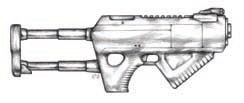
The Raust X-GF posted:
What the Raust X-GF lacks in size, it makes up for in attitude. The large caliber of this weapon creates significant recoil, thus slowing its rate of accurate fire. Its collapsible stock and angled forward grip help the shooter maintain control over the weapon. However, some shooters claim its action is inconsistent. Supporters tend to develop a love-hate relationship with the X-GF, swearing that unless you treat it well, it will get loud, grumpy, and difficult to control.
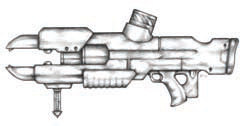
The Promethion X-W1F3 posted:
The Promethion X-W1F3 is a potentially devastating weapon. The ammunition is expensive, but causes a significant amount of Energy damage. As long as the user provides the daily maintenance the weapon requires, the weapon functions quite efficiently. If the user does not adequately care for the X-W1F3, it has been known to occasionally breakdown, creating expensive repair bills. If the user is not careful the X-W1F3 will drain them financially and leave them with a broken shell of a weapon. The X-W1F3 is shown here with a mount connector that allows it to latch securely onto a vehicle or structure.
In case you were worried we'd make it out of this book without a little overt misogyny.
Chapter 10: The one chapter you'll probably never need.
Chapter 10 is titled "Playing the Game" and is basically your bog-standard GM advice and a handful of sample NPCs. After the rest of this post, it's nothing worth lingering on. No sample adventure, no sample wildlife just in case the monster manual never makes it to print, just a few NPCs and it's off to the index and blank character sheet.
Conclusion: THEY MADE AN ARG FOR THIS.
So, that's Alpha Omega, a glossy, over-produced, grossly over-marketed piece of mediocrity that would have gone completely unnoticed had its viral marketing campaign not coincided with some JJ Abrams Mystery Box bullshit. While the monster manual, The Encountered, never got a full physical release, it did eventually make it to PDF format, but I don't own it, and it would mostly just be an exhibition of goofy artwork, anyway, so I'll just leave my little overview here.
FIN
Bonus: SICK GUNS BRAH
Almost every damaging firearm attachment is exhibited at some point in the main guns section (attachments are noted parenthetically so you know that they're not included with purchase), so you can really see how they look. Enjoy.

The CDEM 870 shotgun with attached barrel axe. Agents of SHIELD did it better.
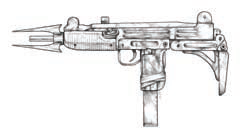
The Cyclical UZI with mini bayonet. Sadly, the full bayonet didn't get a picture, but just imagine those, but bigger and still just totally surrounding the barrel for no reason.
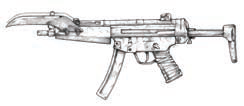
The Mantis MP5A3X, with upper receiver blades. They're totally a different thing from a bayonet, honest.
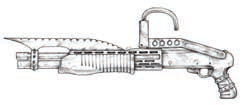
The Cyclical SPAS-12 with over barrel blade. Yes this is also a different thing.
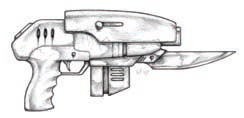
The Raust Intruder with under barrel blade. Except it's referred to in the actual section on attachments as a short weapon bayonet. Get those editors!
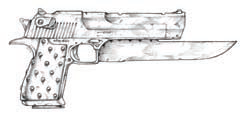
The Mantis Eagle Mark XXV, with the same attachment. It just looks sillier on a realistic-looking gun.
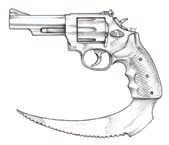
The Raust Model 2620, with under grip serrated blade. I'll let you guys handle this one.
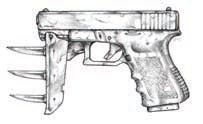
The CDEM 32 US with under barrel punching spikes. The book claims these are meant to be used like brass knuckles. HOW?!
And finally, the pièce de résistance:
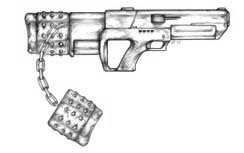
The Misca Thunder, with RETRACTABLE STOCK FLAIL. YES IT IS EXACTLY WHAT IT LOOKS LIKE.
So, there's your frankenguns. Happy Halloween.
EDIT: Oh, right, I almost forgot, here's the logo for the 6-6 System, in case you thought I was making that up:

Yeah.